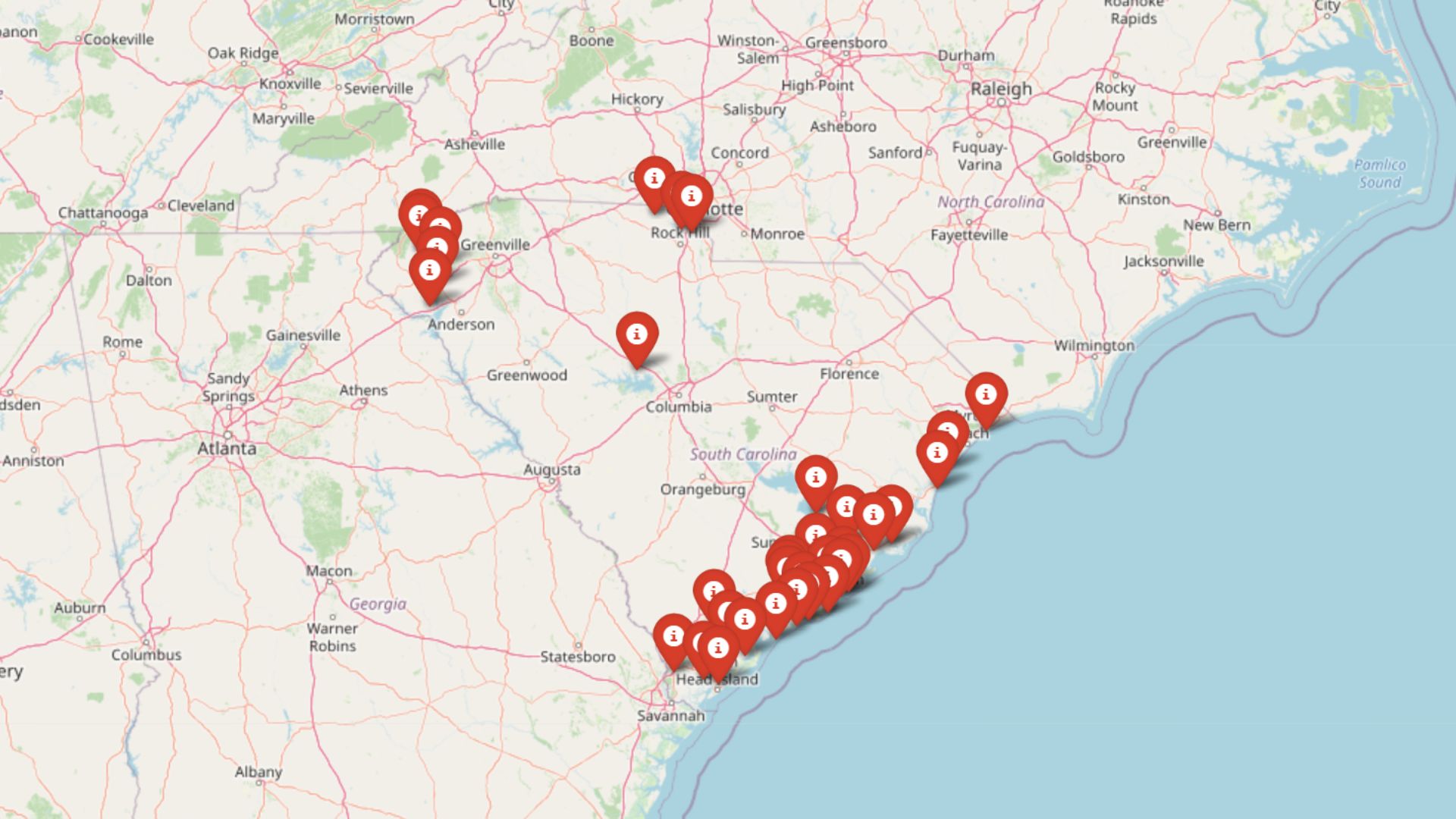
Using the latest Zillow Home Value Index data, we’ve ranked the 30 most expensive towns in Rhode Island based on home price increases since 2010. These communities showcase more than just high values—they reveal stories of coastal appeal, historic preservation, and strategic location that drive sustained demand.
From exclusive island retreats to charming rural enclaves, each town demonstrates unique factors behind its price growth. Whether you’re considering a move, tracking investment opportunities, or simply curious about market trends, this data-driven analysis shows where Rhode Island’s housing costs have climbed highest—and the compelling reasons behind these increases.
30. Johnston – 110% Home Price Increase Since 2010
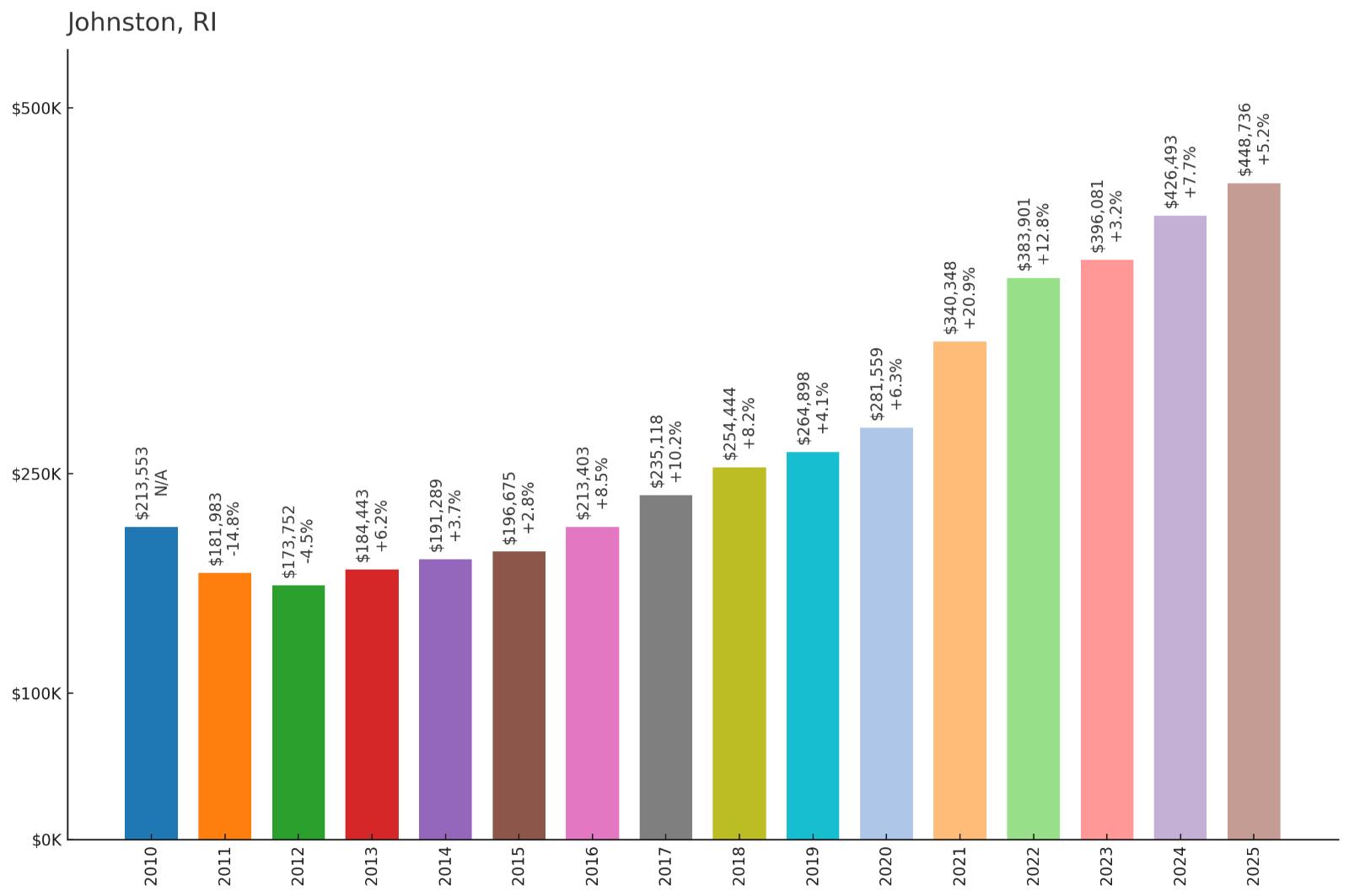
- 2010: $213,553
- 2011: $181,983
- 2012: $173,752
- 2013: $184,443
- 2014: $191,289
- 2015: $196,675
- 2016: $213,403
- 2017: $235,118
- 2018: $254,444
- 2019: $264,898
- 2020: $281,559
- 2021: $340,348
- 2022: $383,901
- 2023: $396,081
- 2024: $426,493
- 2025: $448,736
Johnston experienced steady recovery after significant drops in the early 2010s, with values doubling by 2025. The town saw its biggest jump during the pandemic years, climbing from $281,559 in 2020 to $448,736 today. This suburban Providence community benefits from affordable housing options while maintaining easy access to the capital city.
Why Johnston?
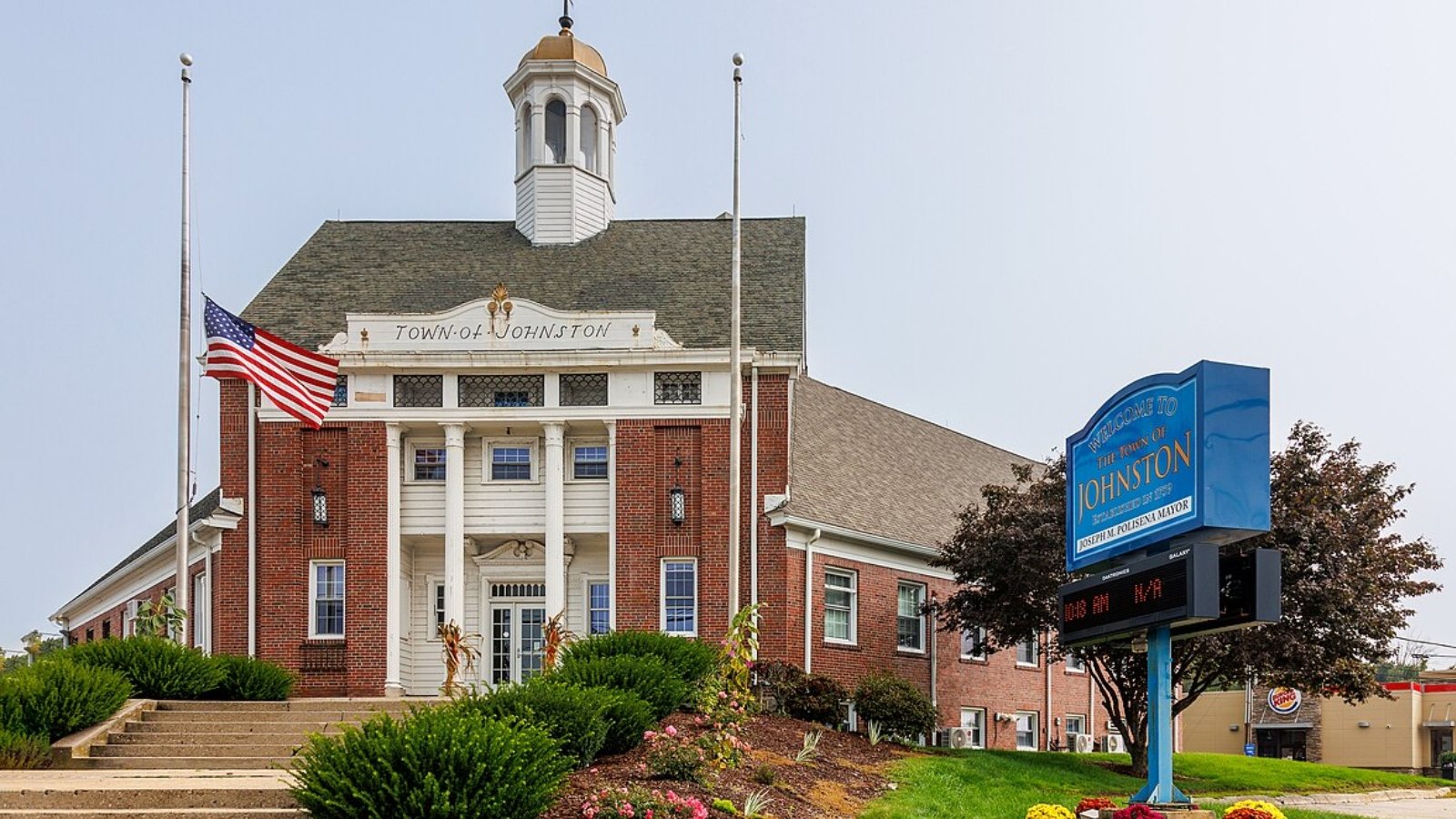
Why are people willing to pay so much to live here? What’s special about it?
Johnston attracts families seeking affordable suburban living with urban convenience just minutes away. The town offers well-maintained neighborhoods, good schools, and a strong sense of community that appeals to first-time homebuyers and young families. Its location provides quick access to downtown Providence while maintaining lower costs than more exclusive areas.
The community features several parks, recreational facilities, and local businesses that create a small-town atmosphere. Johnston also benefits from ongoing development projects and infrastructure improvements that continue to enhance its appeal. This combination of affordability and accessibility makes it an attractive option for buyers priced out of pricier Rhode Island markets.
How Johnston Rose to Prominence
Johnston’s development accelerated in the mid-20th century as Providence’s suburbs expanded westward. Originally agricultural land settled by Italian and Irish immigrants, the town transformed into a residential community as families sought larger lots and newer homes outside the city. The construction of major highways improved accessibility, making Johnston an appealing choice for commuters.
During the 1970s and 1980s, Johnston saw significant residential construction as developers recognized the area’s potential. The town maintained its suburban character while adding shopping centers, schools, and recreational facilities. This balanced growth attracted middle-class families who valued space, safety, and community amenities at reasonable prices.
3 Interesting Tidbits
1. Firefighting Heritage – Johnston is home to one of Rhode Island’s most respected volunteer fire departments, with a tradition dating back over 100 years.
2. Industrial Roots – The town once housed several mills along the Woonasquatucket River, remnants of which can still be seen today in converted residential and commercial properties.
3. Oak Hill Cemetery – This historic cemetery contains graves dating back to the 1700s and serves as a peaceful greenspace for the community.
29. Coventry – 107% Home Price Increase Since 2010
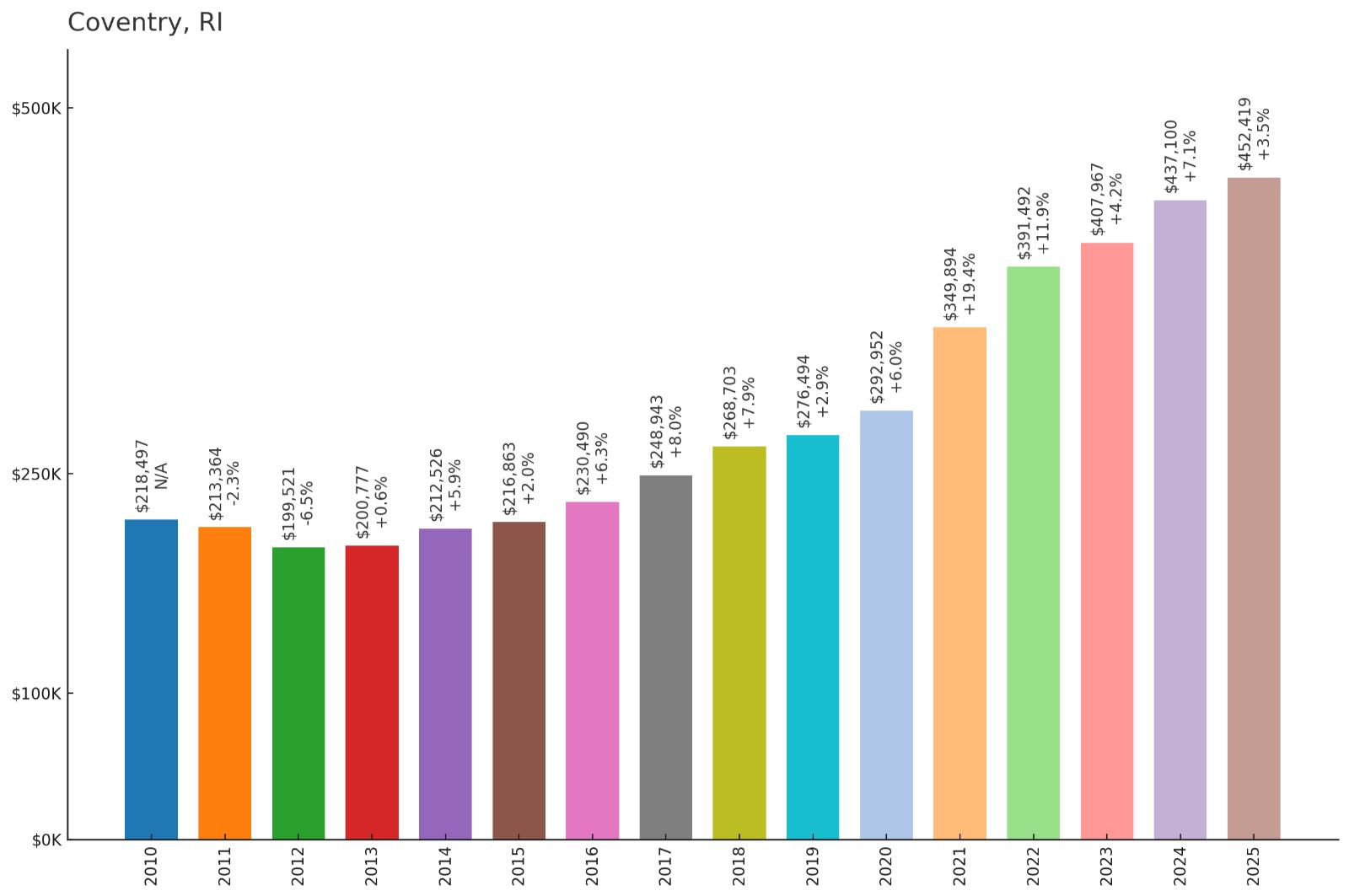
- 2010: $218,497
- 2011: $213,364
- 2012: $199,521
- 2013: $200,777
- 2014: $212,526
- 2015: $216,863
- 2016: $230,490
- 2017: $248,943
- 2018: $268,703
- 2019: $276,494
- 2020: $292,952
- 2021: $349,894
- 2022: $391,492
- 2023: $407,967
- 2024: $437,100
- 2025: $452,419
Coventry’s home values more than doubled since 2010, showing particularly strong momentum after 2020. The town recovered from early-decade lows to reach $452,419 by 2025, demonstrating sustained buyer interest. This western Rhode Island community combines rural charm with growing suburban amenities that attract families seeking space and value.
Why Coventry?
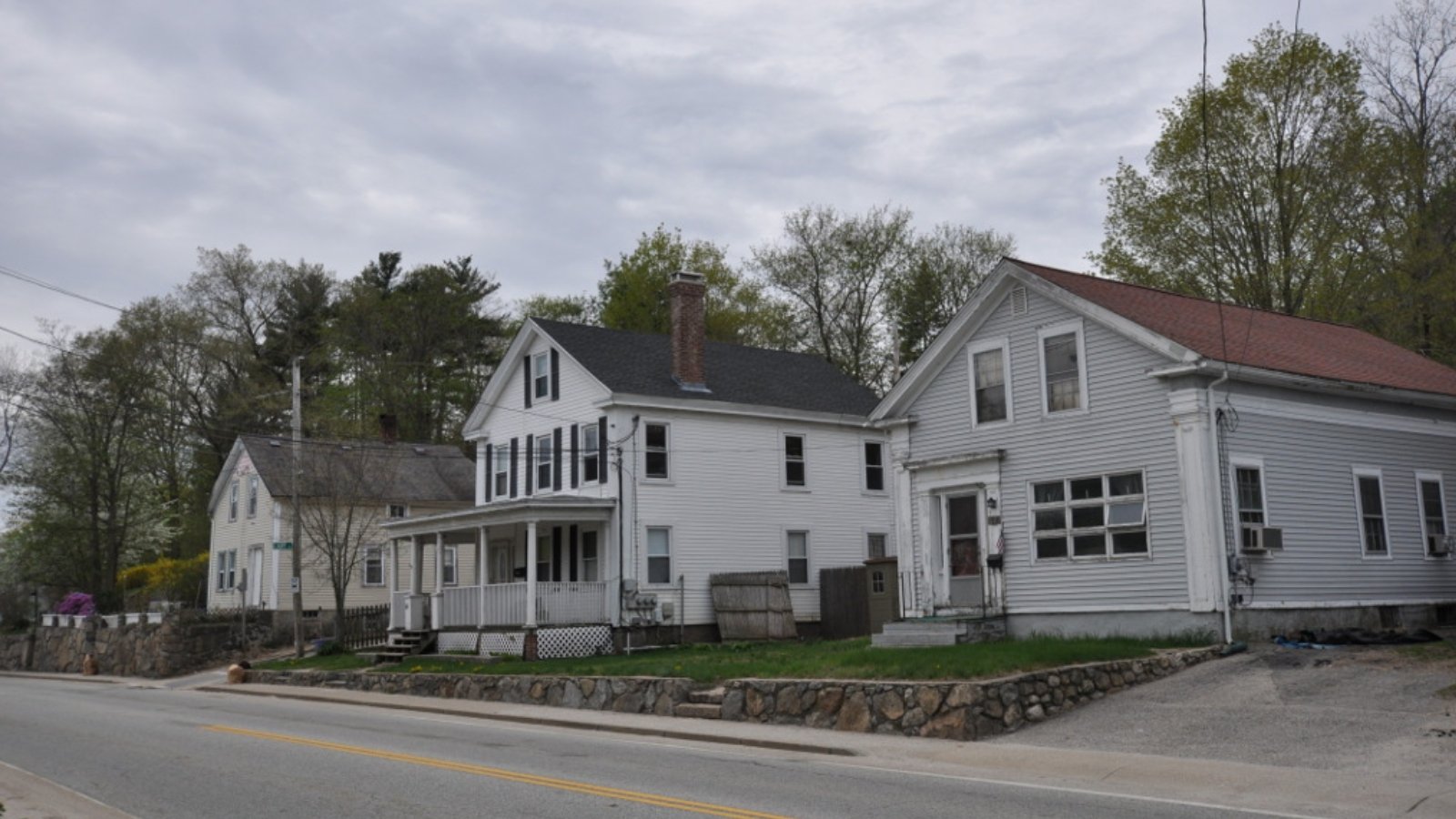
Why are people willing to pay so much to live here? What’s special about it?
Coventry appeals to buyers seeking larger lots, newer construction, and a quieter pace while staying connected to urban centers. The town offers excellent recreational opportunities with numerous lakes, parks, and trails that draw outdoor enthusiasts and families. Its location provides reasonable commutes to both Providence and Hartford, expanding employment options.
The community features strong schools, low crime rates, and a growing retail sector that meets daily needs locally. Coventry’s rural character remains intact despite development, with farms, forests, and open spaces preserved throughout the town. This balance of growth and conservation creates a desirable living environment that justifies rising home values.
How Coventry Rose to Prominence
Coventry’s transformation began in the 1990s as families sought affordable alternatives to expensive coastal and urban areas. The town’s abundant land and lower prices attracted developers who built subdivisions targeting middle-income families. Highway improvements and commercial development followed, creating the infrastructure needed to support a growing population.
The early 2000s saw continued residential expansion as Coventry marketed itself as a family-friendly community with recreational amenities. Lake communities like Tiogue and Johnson’s Pond became particularly popular, offering waterfront living at accessible prices. This steady growth established Coventry as a desirable suburban destination within Rhode Island’s housing market.
3 Interesting Tidbits
1. Lake Life – Coventry contains over 15 lakes and ponds, making it Rhode Island’s premier freshwater recreational destination.
2. War Memorial – The town maintains one of the state’s most comprehensive veterans memorials, honoring local service members from all major conflicts.
3. Paine House Museum – This historic site preserves colonial-era architecture and artifacts, showcasing Coventry’s role in early American history.
28. Burrillville – 94% Home Price Increase Since 2010
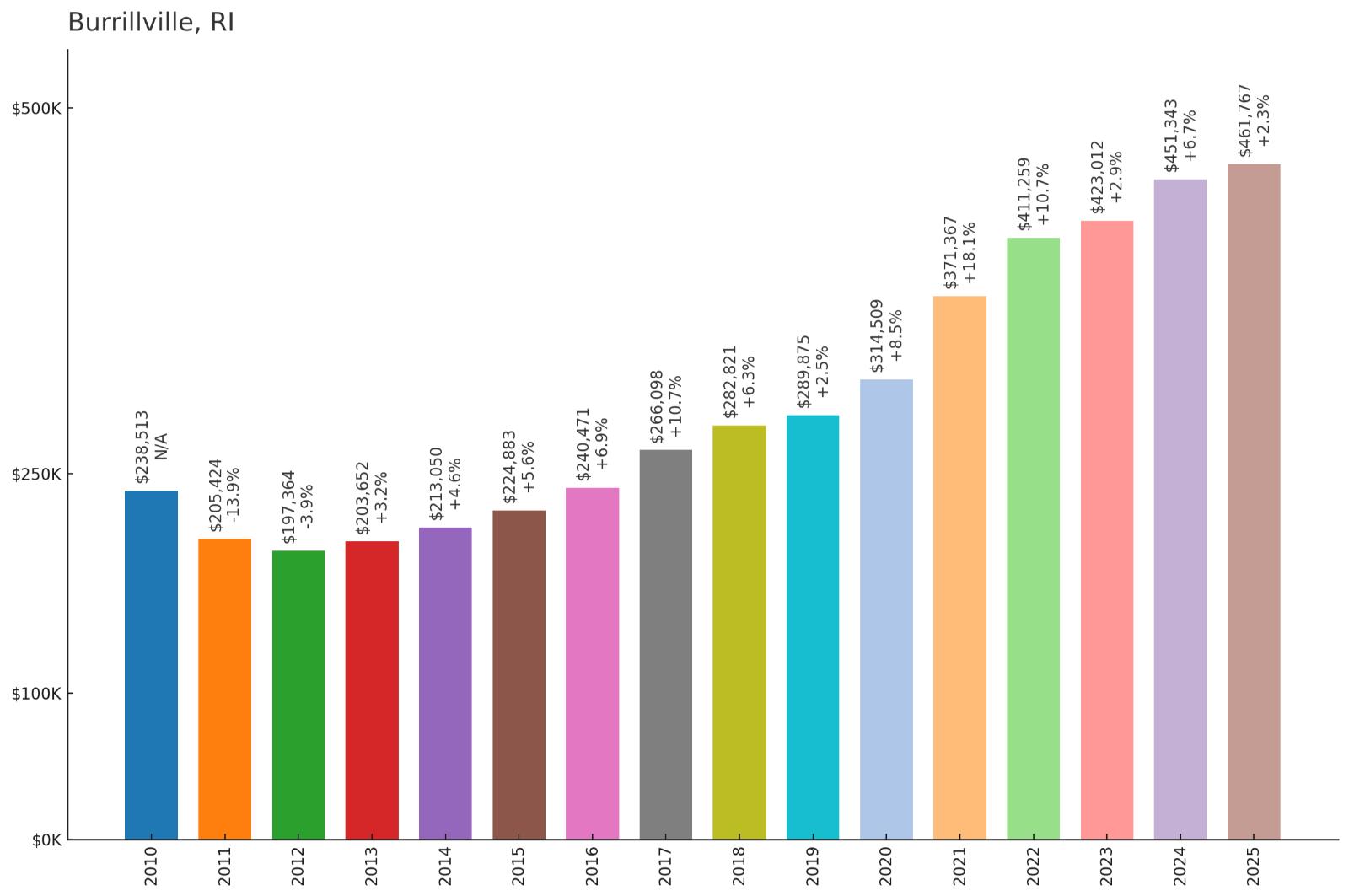
- 2010: $238,513
- 2011: $205,424
- 2012: $197,364
- 2013: $203,652
- 2014: $213,050
- 2015: $224,883
- 2016: $240,471
- 2017: $266,098
- 2018: $282,821
- 2019: $289,875
- 2020: $314,509
- 2021: $371,367
- 2022: $411,259
- 2023: $423,012
- 2024: $451,343
- 2025: $461,767
Burrillville saw dramatic growth after weathering early-decade challenges, nearly doubling home values to reach $461,767 by 2025. The rural northwest community experienced its strongest gains during 2020-2022, reflecting increased demand for larger properties and outdoor space. This trend highlights Burrillville’s appeal as buyers prioritized room to breathe over urban proximity.
Why Burrillville?
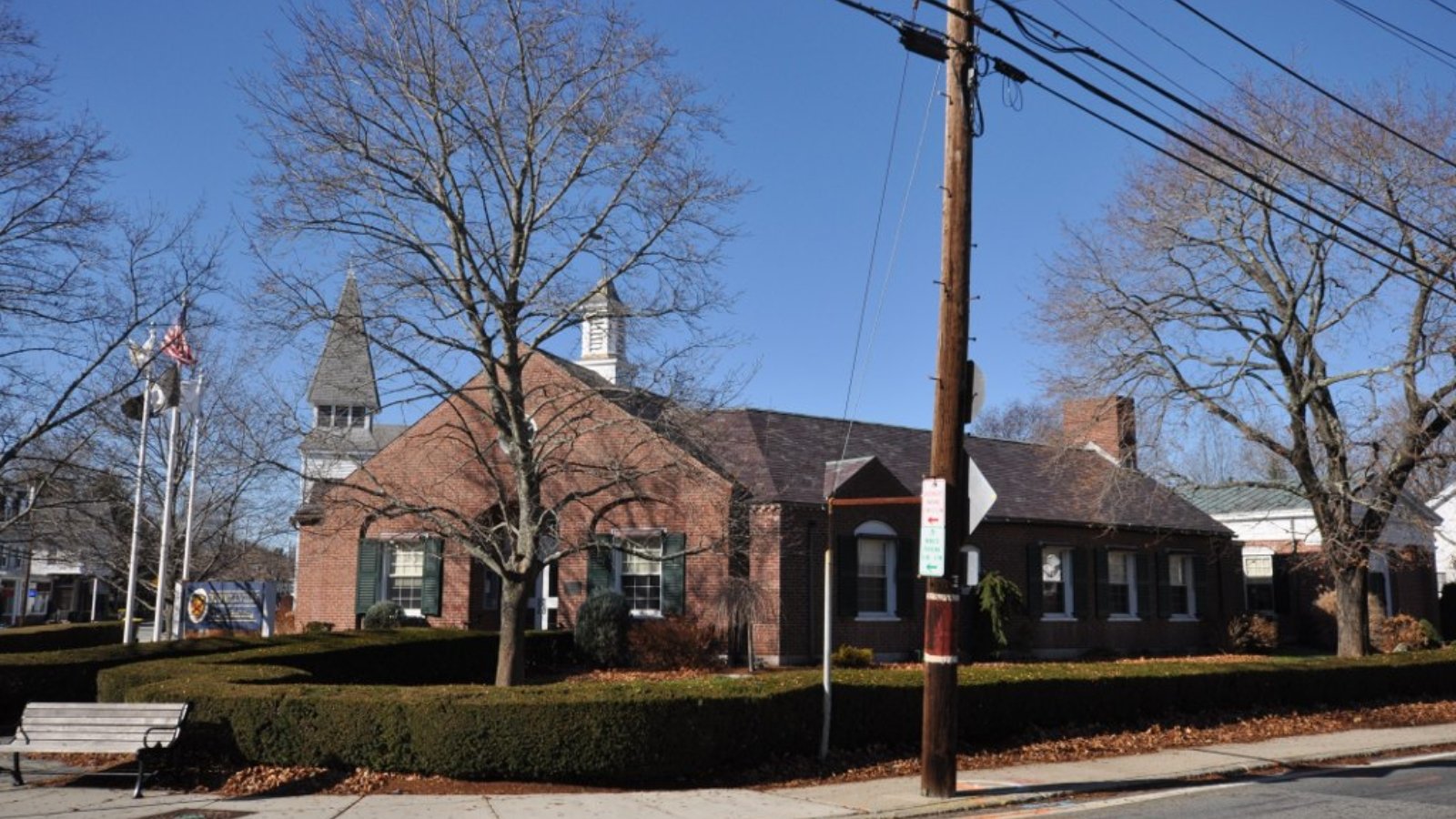
Why are people willing to pay so much to live here? What’s special about it?
Burrillville attracts buyers seeking rural tranquility without completely sacrificing modern conveniences. The town offers expansive lots, custom home opportunities, and stunning natural settings that appeal to those wanting privacy and space. Its location near the Massachusetts border provides access to both states’ employment markets while maintaining lower living costs.
The community features abundant outdoor recreation with state forests, hiking trails, and pristine lakes that draw nature enthusiasts year-round. Burrillville’s small-town atmosphere includes local farms, historic sites, and community events that create strong neighborhood connections. This authentic rural lifestyle becomes increasingly valuable as development pressures mount elsewhere.
How Burrillville Rose to Prominence
Burrillville’s real estate market gained momentum in the 2010s as buyers discovered its combination of affordability and natural beauty. The town’s mill villages like Harrisville and Oakland retained their historic character while attracting families seeking alternatives to suburban sprawl. Strategic preservation efforts maintained the area’s rural appeal while allowing selective development.
The pandemic accelerated interest in Burrillville as remote work made location less critical for many professionals. Buyers fleeing urban areas found the town’s large lots, reasonable prices, and outdoor amenities particularly attractive. This influx brought new energy and investment to the community while preserving its essential rural character.
3 Interesting Tidbits
1. Mill Heritage – The town preserves several historic mill villages that showcase Rhode Island’s industrial past, including the picturesque Harrisville community.
2. Wildlife Haven – Burrillville’s forests and wetlands support diverse wildlife populations, making it a popular destination for hunting, fishing, and nature photography.
3. Border Benefits – The town’s location allows residents to easily access Massachusetts attractions, shopping, and employment while enjoying Rhode Island’s lower property taxes.
27. Hopkinton – 108% Home Price Increase Since 2010
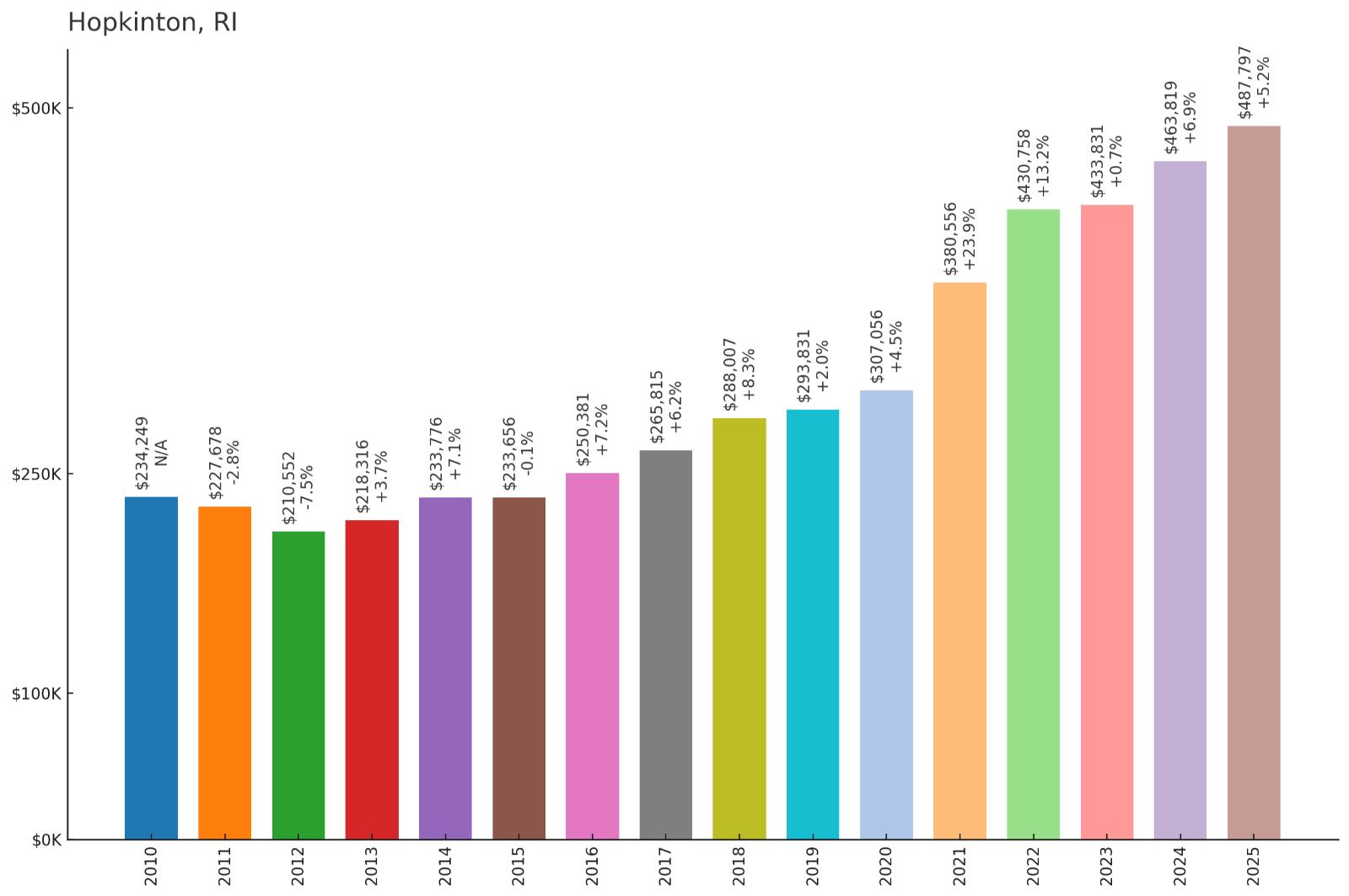
- 2010: $234,249
- 2011: $227,678
- 2012: $210,552
- 2013: $218,316
- 2014: $233,776
- 2015: $233,656
- 2016: $250,381
- 2017: $265,815
- 2018: $288,007
- 2019: $293,831
- 2020: $307,056
- 2021: $380,556
- 2022: $430,758
- 2023: $433,831
- 2024: $463,819
- 2025: $487,797
Hopkinton’s values more than doubled since 2010, reaching $487,797 by 2025 after steady growth throughout the period. The southwestern Rhode Island town benefited from consistent demand for rural properties, with particularly strong gains during 2020-2022. This growth reflects buyer interest in the area’s natural beauty and recreational opportunities.
Why Hopkinton?
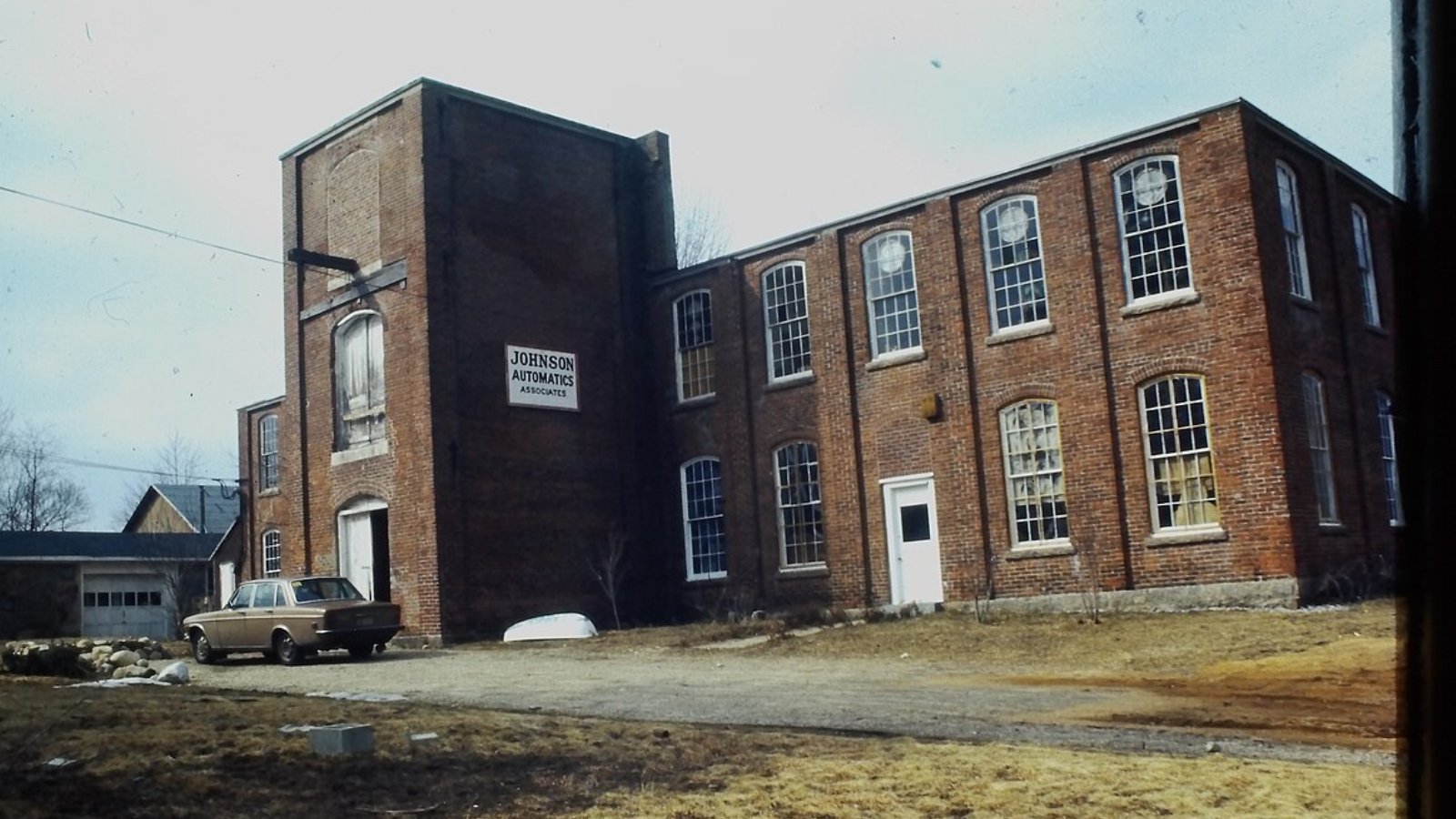
Why are people willing to pay so much to live here? What’s special about it?
Hopkinton appeals to outdoor enthusiasts and families seeking space, privacy, and natural beauty at reasonable prices. The town offers direct access to beaches, state parks, and recreational facilities that create year-round lifestyle benefits. Its rural character includes working farms, forests, and open spaces that provide an authentic country living experience.
The community maintains low crime rates, good schools, and a strong sense of place that attracts long-term residents. Hopkinton’s location provides convenient access to coastal attractions while offering larger lots and newer construction options. This combination of lifestyle benefits and practical advantages justifies the area’s rising property values.
How Hopkinton Rose to Prominence
Hopkinton’s real estate market strengthened as coastal areas became increasingly expensive, driving buyers inland to seek value and space. The town’s proximity to popular beach destinations made it attractive to families wanting seasonal access without year-round coastal costs. Development remained measured, preserving the rural character that originally drew residents.
The 2010s brought increased attention to Hopkinton’s recreational assets, particularly its state park lands and outdoor facilities. Marketing efforts highlighted the town’s quality of life benefits, drawing families from more crowded areas. This organic growth pattern maintained community character while supporting steady property value increases.
3 Interesting Tidbits
1. Rockville Management Area – This expansive state facility offers hiking, fishing, and hunting opportunities right within the town borders.
2. Agricultural Heritage – Several working farms continue operating in Hopkinton, maintaining the area’s rural character and providing local food sources.
3. Arcadia Gateway – The town serves as a primary access point to Rhode Island’s largest state management area, drawing outdoor recreation enthusiasts from across the region.
26. Smithfield – 95% Home Price Increase Since 2010
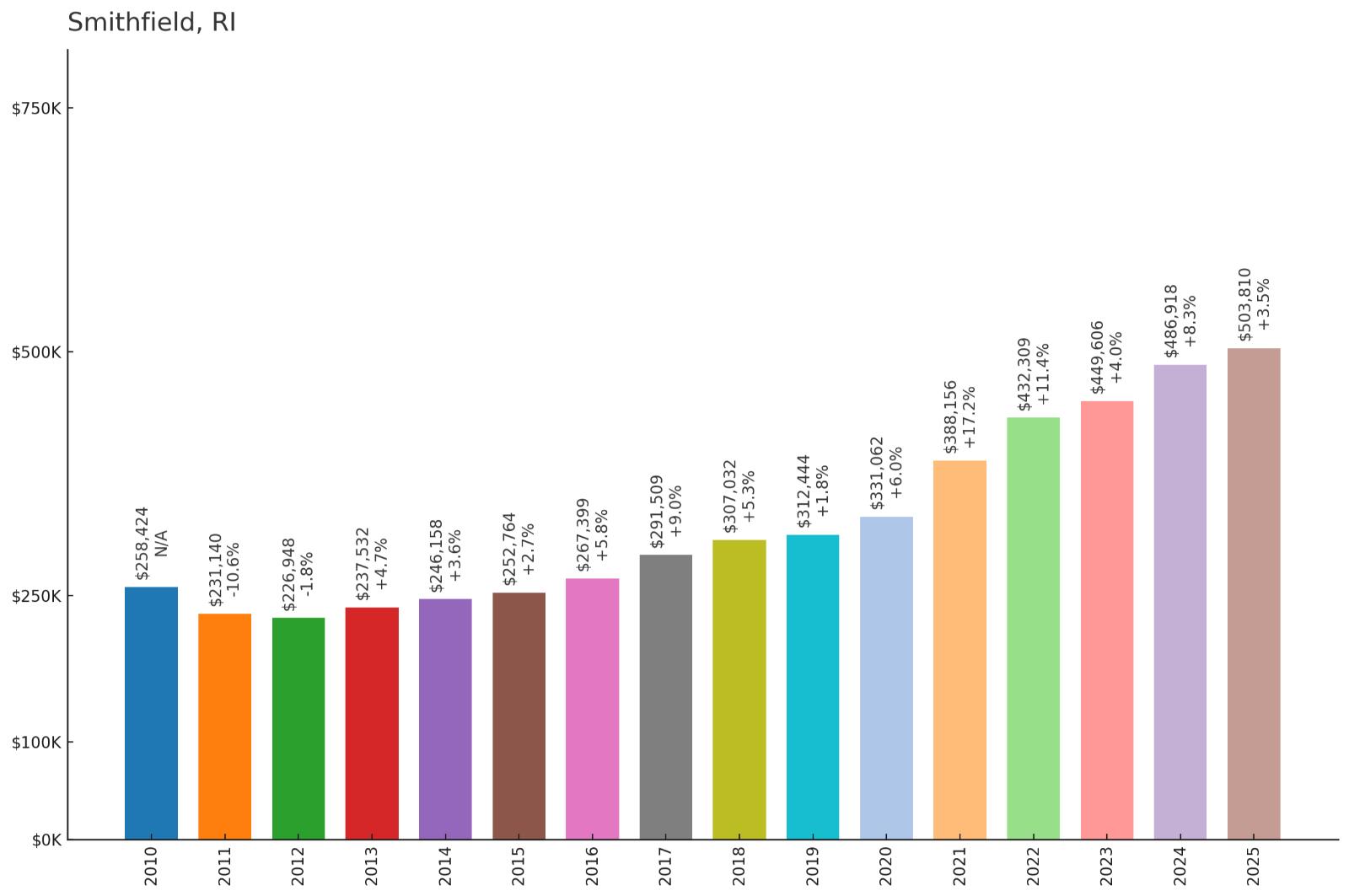
- 2010: $258,424
- 2011: $231,140
- 2012: $226,948
- 2013: $237,532
- 2014: $246,158
- 2015: $252,764
- 2016: $267,399
- 2017: $291,509
- 2018: $307,032
- 2019: $312,444
- 2020: $331,062
- 2021: $388,156
- 2022: $432,309
- 2023: $449,606
- 2024: $486,918
- 2025: $503,810
Smithfield’s home values nearly doubled since 2010, climbing steadily to $503,810 by 2025. The northern Rhode Island town recovered from early-decade softness to post consistent gains, with acceleration during the pandemic years. This growth pattern reflects sustained demand for the community’s suburban amenities and strategic location.
Why Smithfield?
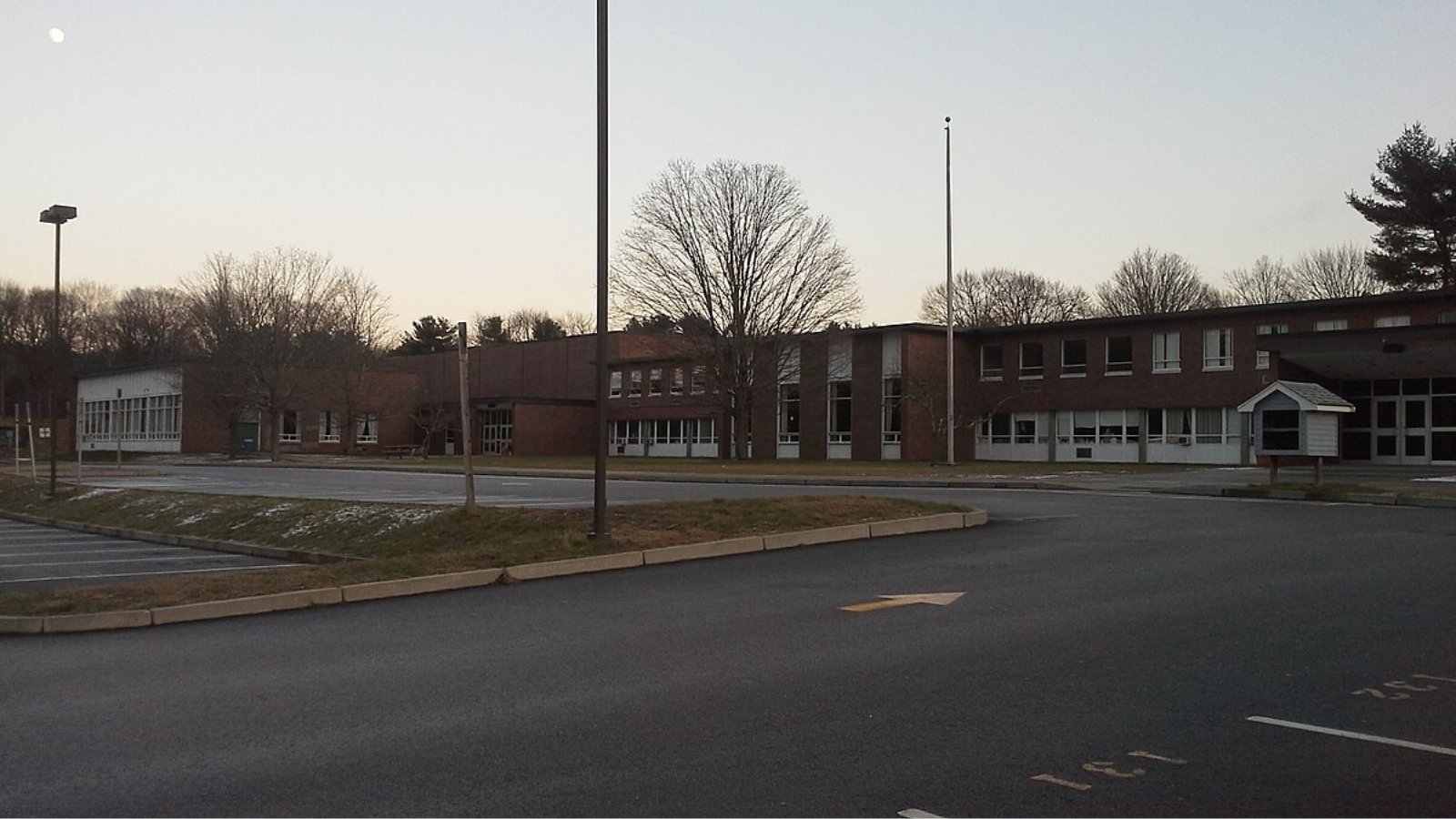
Why are people willing to pay so much to live here? What’s special about it?
Smithfield offers an attractive mix of suburban convenience and rural charm that appeals to families and professionals. The town features excellent schools, well-maintained neighborhoods, and ample recreational facilities including parks, trails, and sports complexes. Its location provides easy access to Providence while maintaining a quieter, more spacious environment.
The community benefits from ongoing commercial development that brings shopping, dining, and services closer to home. Smithfield’s historic apple orchards, farms, and conservation areas preserve green space while new subdivisions offer modern amenities. This balance of old and new creates broad appeal across different buyer demographics.
How Smithfield Rose to Prominence
Smithfield’s growth accelerated in the 1980s and 1990s as Providence’s suburbs expanded northward. The town’s rural character and available land attracted developers who built family-oriented subdivisions and commercial centers. Apple Valley Mall and other retail developments established Smithfield as a regional shopping destination, supporting continued residential growth.
The early 2000s brought luxury home development and upscale amenities that elevated the town’s profile. Bryant University’s presence added educational and cultural value while generating economic activity. This institutional anchor, combined with ongoing residential development, positioned Smithfield as a desirable suburban community within the Providence metropolitan area.
3 Interesting Tidbits
1. Apple Heritage – The town’s historic apple orchards still operate today, offering seasonal picking and maintaining agricultural traditions dating back centuries.
2. University Town – Bryant University brings academic prestige, cultural events, and economic activity that enhance the community’s appeal and stability.
3. Conservation Success – Smithfield has preserved over 1,000 acres of open space through strategic land acquisition and conservation easements.
25. Glocester – 138% Home Price Increase Since 2010

- 2010: $213,225
- 2011: $207,089
- 2012: $200,642
- 2013: $210,314
- 2014: $231,654
- 2015: $242,841
- 2016: $260,431
- 2017: $279,933
- 2018: $305,267
- 2019: $310,956
- 2020: $328,589
- 2021: $394,995
- 2022: $437,512
- 2023: $451,399
- 2024: $496,551
- 2025: $506,583
Glocester posted one of Rhode Island’s highest growth rates, with values climbing 138% since 2010 to reach $506,583 by 2025. This rural northwestern community saw particularly strong gains after 2020, reflecting increased demand for country properties and larger lots. The town’s combination of natural beauty and affordable entry points attracted buyers throughout the period.
Why Glocester?

Magicpiano, CC BY-SA 3.0 , via Wikimedia Commons
Why are people willing to pay so much to live here? What’s special about it?
Glocester attracts buyers seeking authentic rural living with modern conveniences within reach. The town offers spectacular natural settings including forests, lakes, and rolling hills that provide privacy and outdoor recreation opportunities. Its historic villages like Chepachet maintain New England charm while offering unique shopping and dining experiences.
The community appeals to those wanting large lots, custom homes, and a slower pace of life without complete isolation. Glocester’s reasonable commute to Providence makes it viable for professionals seeking rural tranquility. The town’s conservation efforts and zoning protect its character while allowing selective development that maintains property values.
How Glocester Rose to Prominence
Glocester’s real estate market gained momentum as buyers discovered its combination of affordability and natural beauty. The town’s historic mill villages and rural roads attracted those seeking alternatives to suburban development patterns. Strategic preservation efforts maintained authentic character while allowing growth in appropriate areas.
The pandemic accelerated interest in Glocester as remote work made location less critical and families prioritized space and outdoor access. Recent market analysis shows the town’s rural charm and scenic landscapes have driven significant appreciation. This influx brought new investment while respecting the community’s rural heritage and environmental values.
3 Interesting Tidbits
1. Chepachet Village – This historic mill village features antique shops, craft stores, and restaurants that draw visitors from across New England.
2. Dorr Rebellion – The town played a significant role in Rhode Island’s 1841-1842 constitutional crisis, with historic sites commemorating these events.
3. George Washington Slept Here – The Steere House Bed & Breakfast occupies a building where President Washington actually stayed during his 1790 New England tour.
24. Cumberland – 99% Home Price Increase Since 2010

- 2010: $259,071
- 2011: $242,956
- 2012: $227,856
- 2013: $239,770
- 2014: $250,248
- 2015: $253,910
- 2016: $270,257
- 2017: $291,516
- 2018: $317,107
- 2019: $322,540
- 2020: $336,477
- 2021: $405,645
- 2022: $446,299
- 2023: $456,924
- 2024: $493,412
- 2025: $514,459
Cumberland’s home values nearly doubled since 2010, reaching $514,459 by 2025 after steady upward momentum. The northern Rhode Island town experienced consistent growth with acceleration during 2020-2022, reflecting strong demand for its suburban amenities and convenient location. This pattern demonstrates sustained buyer confidence in the community’s long-term appeal.
Why Cumberland?

Why are people willing to pay so much to live here? What’s special about it?
Cumberland attracts families seeking suburban comfort with excellent schools, safe neighborhoods, and reasonable commutes to Providence and Boston. The town offers well-established residential areas, recreational facilities, and shopping options that meet daily needs locally. Its location provides the best of both worlds—suburban tranquility with urban accessibility.
The community features numerous parks, sports facilities, and cultural amenities that enhance quality of life for residents. Cumberland’s stable municipal services, good infrastructure, and strong property values make it attractive to long-term homeowners. This combination of practical benefits and lifestyle advantages supports continued demand and price appreciation.
How Cumberland Rose to Prominence
Cumberland’s development accelerated in the post-World War II era as Providence’s suburbs expanded northward. The town’s rural character gradually gave way to residential subdivisions and commercial centers that served growing populations. Strategic planning balanced development with preservation of green spaces and community character.
The 1980s and 1990s brought significant residential construction as Cumberland established itself as a desirable suburban destination. The town’s proximity to major employment centers, combined with good schools and municipal services, attracted middle-class families seeking stability and value. This consistent appeal has sustained the real estate market through various economic cycles.
3 Interesting Tidbits
1. Monastery Connection – The famous Trappist monastery of Our Lady of the Valley operates within Cumberland, producing artisanal foods and maintaining peaceful grounds.
2. Revolutionary Heritage – Several sites within Cumberland played roles in the Revolutionary War, including historic homes and meeting places preserved today.
3. Diamond Hill Park – This popular state park within Cumberland offers hiking trails, skiing, and year-round recreational opportunities for residents and visitors.
23. North Smithfield – 91% Home Price Increase Since 2010
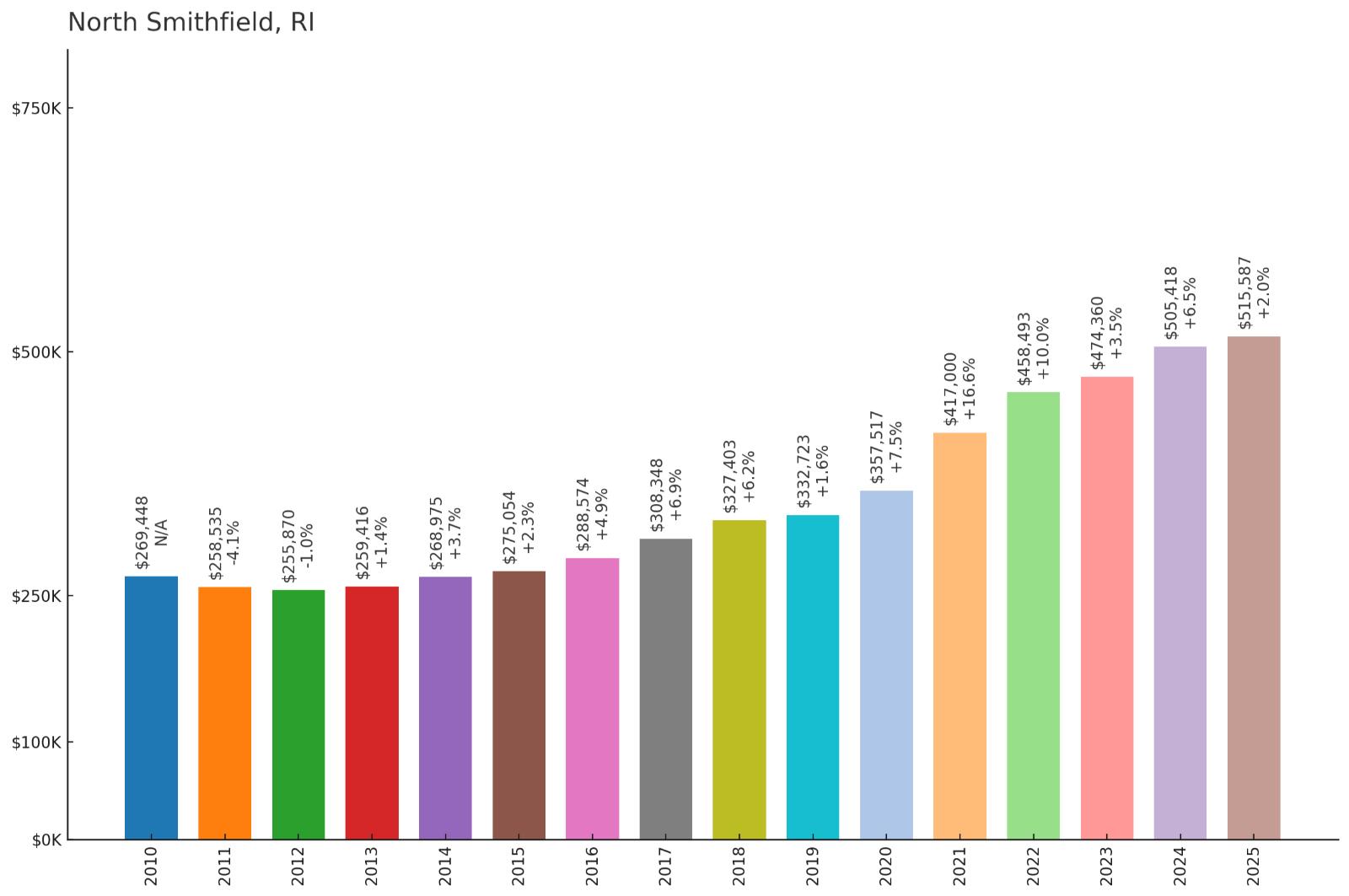
- 2010: $269,448
- 2011: $258,535
- 2012: $255,870
- 2013: $259,416
- 2014: $268,975
- 2015: $275,054
- 2016: $288,574
- 2017: $308,348
- 2018: $327,403
- 2019: $332,723
- 2020: $357,517
- 2021: $417,000
- 2022: $458,493
- 2023: $474,360
- 2024: $505,418
- 2025: $515,587
North Smithfield showed steady appreciation with values climbing 91% since 2010 to reach $515,587 by 2025. The rural northern community maintained consistent growth throughout the period, with notable acceleration after 2020. This performance reflects buyer interest in the town’s combination of space, natural beauty, and reasonable proximity to urban centers.
Why North Smithfield?

Why are people willing to pay so much to live here? What’s special about it?
North Smithfield appeals to buyers seeking rural tranquility with modern conveniences within reasonable reach. The town offers larger lots, newer construction options, and abundant natural settings that provide privacy and outdoor recreation opportunities. Its location near the Massachusetts border expands employment and cultural options while maintaining lower Rhode Island living costs.
The community features excellent schools, low crime rates, and strong municipal services that attract families and professionals. North Smithfield’s conservation efforts preserve forests, farms, and open spaces that enhance quality of life. This balance of development and preservation creates lasting appeal that supports steady property value growth.
How North Smithfield Rose to Prominence
North Smithfield’s transformation accelerated in the 1990s as families discovered its combination of affordability and rural charm. The town’s strategic location between Providence and Worcester, Massachusetts, made it attractive to commuters seeking space and value. Residential development remained measured, preserving the community’s essential character.
The early 2000s brought increased recognition of North Smithfield’s lifestyle benefits, including outdoor recreation, good schools, and municipal stability. The town successfully balanced growth pressures with conservation goals, maintaining appeal for buyers seeking authentic rural living. This approach has sustained demand and supported consistent property value appreciation.
3 Interesting Tidbits
1. Pulaski Memorial – The town honors Revolutionary War hero General Casimir Pulaski with a memorial and annual celebrations recognizing Polish-American heritage.
2. Apple Country – Several working apple orchards continue operating in North Smithfield, offering seasonal picking and maintaining agricultural traditions.
3. Woonsocket Reservoir – This large water body within the town provides recreational opportunities while serving as a crucial regional water resource.
22. Richmond – 115% Home Price Increase Since 2010
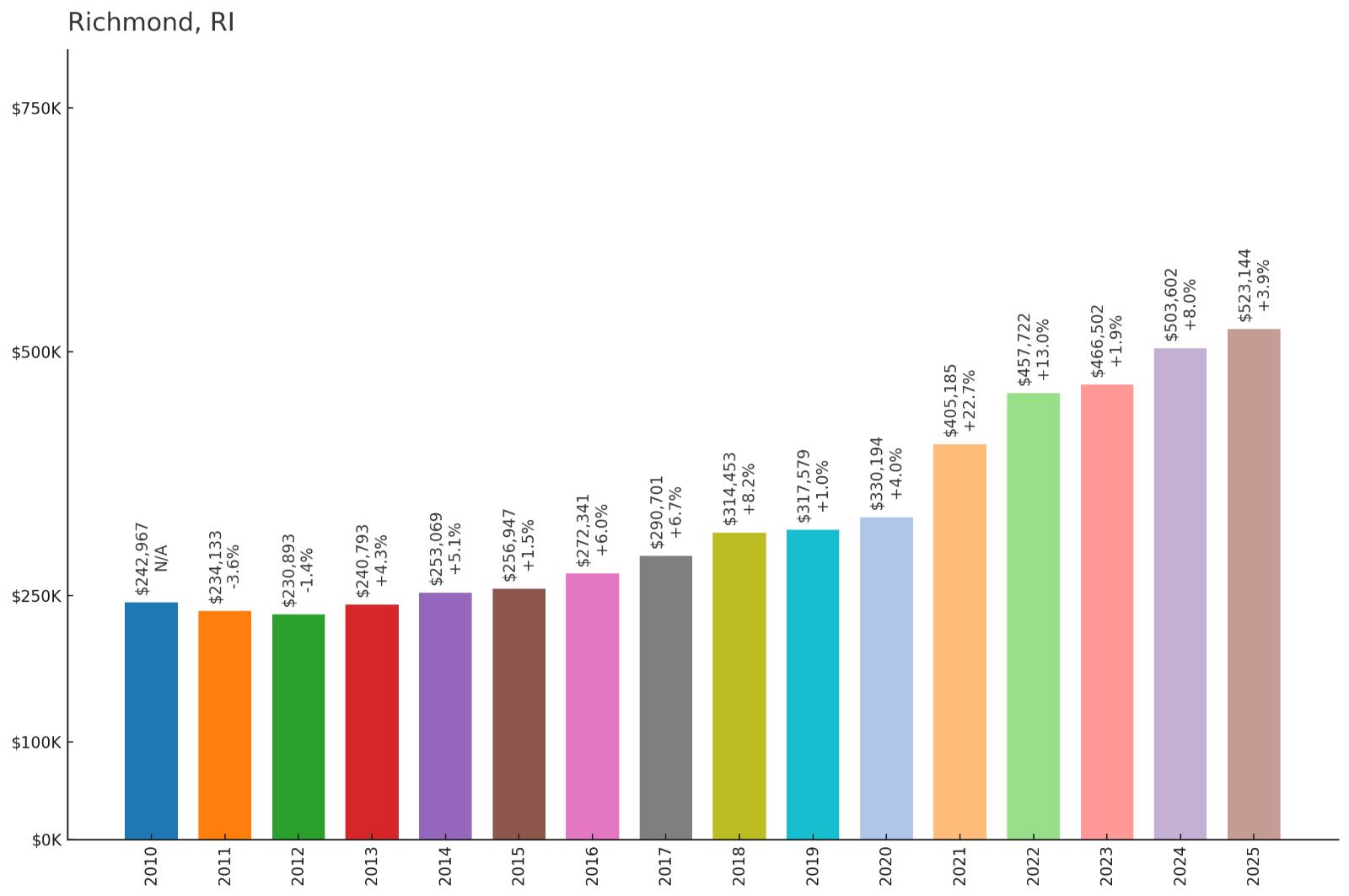
- 2010: $242,967
- 2011: $234,133
- 2012: $230,893
- 2013: $240,793
- 2014: $253,069
- 2015: $256,947
- 2016: $272,341
- 2017: $290,701
- 2018: $314,453
- 2019: $317,579
- 2020: $330,194
- 2021: $405,185
- 2022: $457,722
- 2023: $466,502
- 2024: $503,602
- 2025: $523,144
Richmond experienced impressive growth with home values more than doubling since 2010, reaching $523,144 by 2025. The rural southwestern community saw particularly strong gains during 2020-2022, reflecting increased demand for country properties with recreational access. This growth demonstrates buyer appreciation for Richmond’s natural assets and lifestyle benefits.
Why Richmond?

Why are people willing to pay so much to live here? What’s special about it?
Richmond attracts outdoor enthusiasts and families seeking rural living with easy access to recreational amenities. The town borders Connecticut and offers direct access to numerous state parks, forests, and recreational facilities that provide year-round outdoor activities. Its rural character includes working farms, historic sites, and abundant natural beauty.
The community offers larger lots, custom home opportunities, and a peaceful pace of life that appeals to those escaping urban density. Richmond’s location provides reasonable commutes to multiple employment centers while maintaining authentic country living. This combination of lifestyle benefits and practical accessibility drives sustained demand and property value growth.
How Richmond Rose to Prominence
Richmond’s real estate market gained momentum as buyers discovered its combination of natural beauty, recreational access, and affordable entry points. The town’s location near popular outdoor destinations made it attractive to families wanting country living with recreational amenities. Strategic conservation efforts preserved the area’s essential rural character while allowing appropriate development.
The pandemic accelerated interest in Richmond as remote work made location less critical and families prioritized space and outdoor access. The town’s recreational assets, including access to state management areas and outdoor facilities, became increasingly valuable. This trend brought new residents while respecting the community’s rural heritage and environmental values.
3 Interesting Tidbits
1. Outdoor Paradise – Richmond provides access to multiple state management areas offering hiking, hunting, fishing, and other outdoor recreation opportunities.
2. Historic Crossroads – The town sits at the intersection of historic transportation routes, with several preserved sites commemorating its role in regional development.
3. Agricultural Heritage – Working farms continue operating throughout Richmond, maintaining the area’s rural character and providing local agricultural products.
21. Warren – 150% Home Price Increase Since 2010
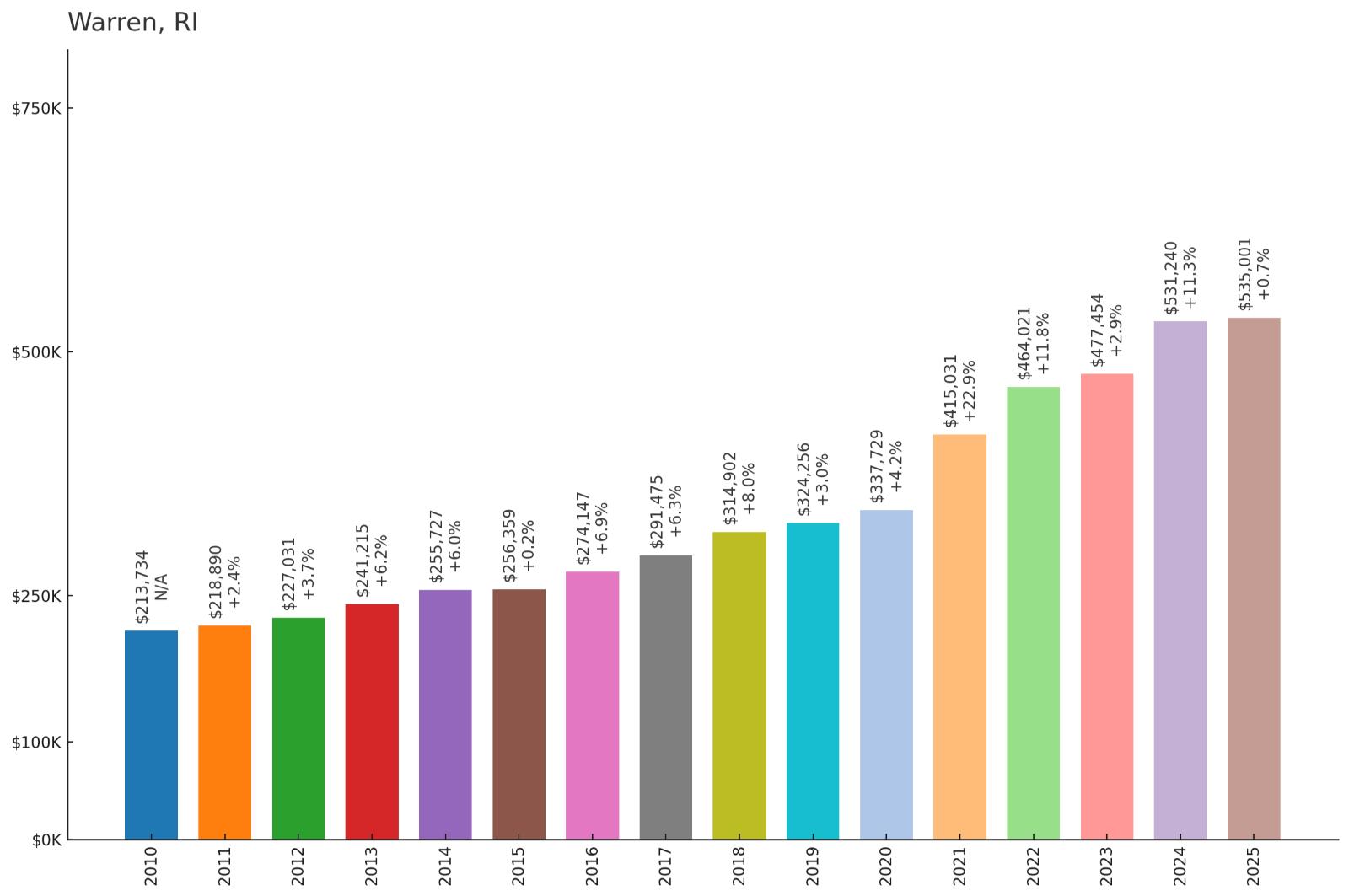
- 2010: $213,734
- 2011: $218,890
- 2012: $227,031
- 2013: $241,215
- 2014: $255,727
- 2015: $256,359
- 2016: $274,147
- 2017: $291,475
- 2018: $314,902
- 2019: $324,256
- 2020: $337,729
- 2021: $415,031
- 2022: $464,021
- 2023: $477,454
- 2024: $531,240
- 2025: $535,001
Warren achieved exceptional growth with home values increasing 150% since 2010, reaching $535,001 by 2025. This waterfront community showed consistent upward momentum throughout the period, with particularly strong gains during 2021-2024. The impressive performance reflects buyer demand for Warren’s historic charm, waterfront access, and cultural amenities.
Why Warren?
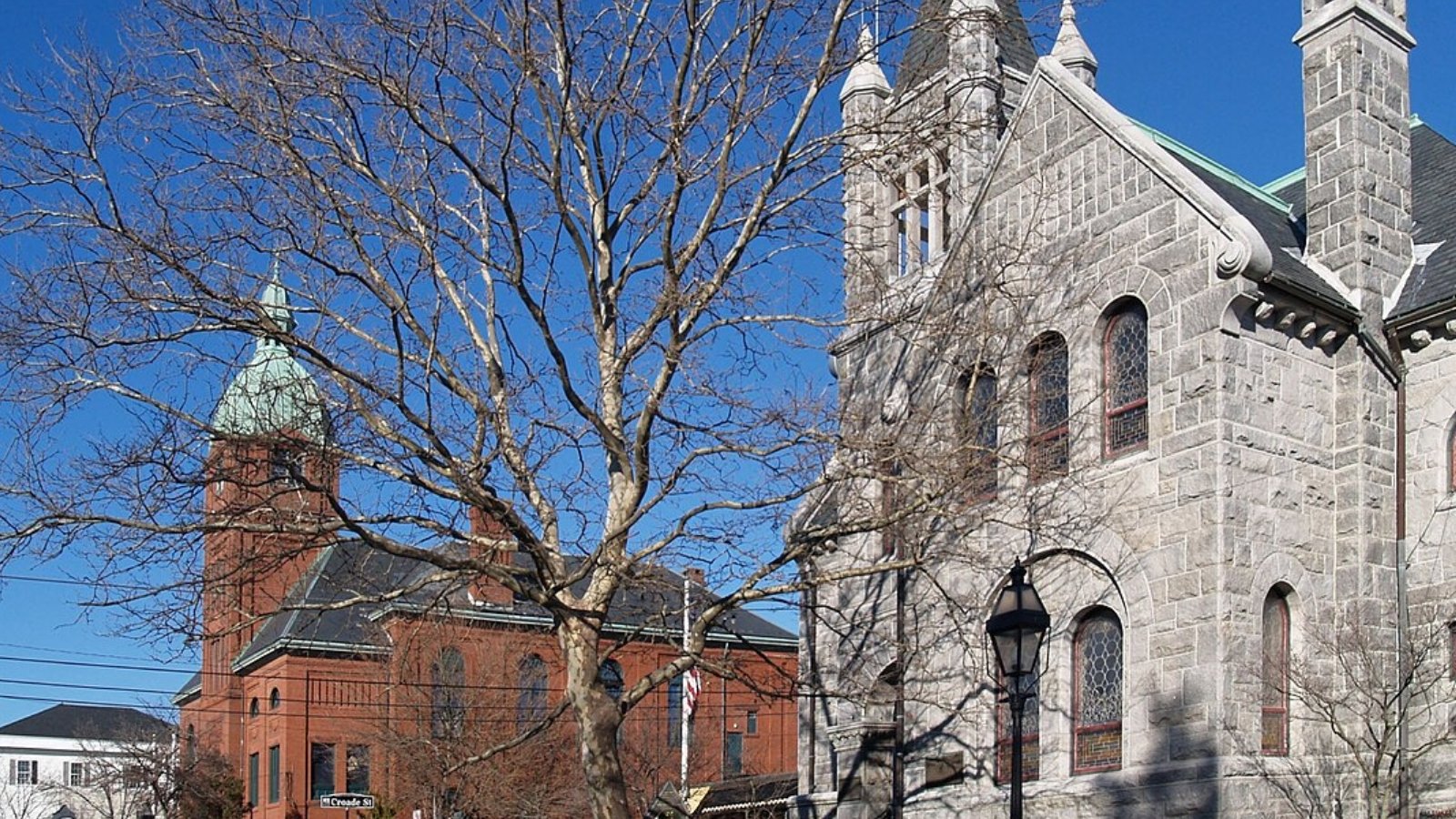
Why are people willing to pay so much to live here? What’s special about it?
Warren attracts buyers with its authentic New England coastal charm, historic downtown, and direct waterfront access. The town offers a walkable main street with local shops, restaurants, and cultural venues that create vibrant community life. Its location on the Warren River provides boating, fishing, and water recreation opportunities right in town.
The community features well-preserved historic architecture, annual festivals, and strong local traditions that create unique character and appeal. Warren’s reasonable size maintains small-town intimacy while offering sophisticated amenities and easy access to Providence. This combination of authenticity and convenience drives sustained buyer interest and property value appreciation.
How Warren Rose to Prominence
Warren’s transformation began in the 1990s as buyers discovered its combination of historic charm, waterfront access, and reasonable prices compared to Newport. The town’s well-preserved downtown and authentic maritime character attracted those seeking alternatives to more touristy coastal areas. Strategic preservation efforts maintained the community’s essential appeal while allowing appropriate development.
The early 2000s brought increased recognition of Warren’s lifestyle benefits, including cultural events, local businesses, and waterfront recreation. The town successfully marketed itself as an authentic New England coastal community with modern amenities. This positioning attracted professionals and retirees seeking character, convenience, and water access at reasonable prices.
3 Interesting Tidbits
1. Quahog Capital – Warren hosts an annual quahog festival celebrating the town’s maritime heritage and local shellfish industry.
2. Historic Downtown – The well-preserved main street features 18th and 19th-century architecture housing contemporary shops, restaurants, and cultural venues.
3. Bike Path Gateway – Warren serves as a key access point to the East Bay Bike Path, a popular recreational trail connecting multiple coastal communities.
20. Tiverton – 124% Home Price Increase Since 2010
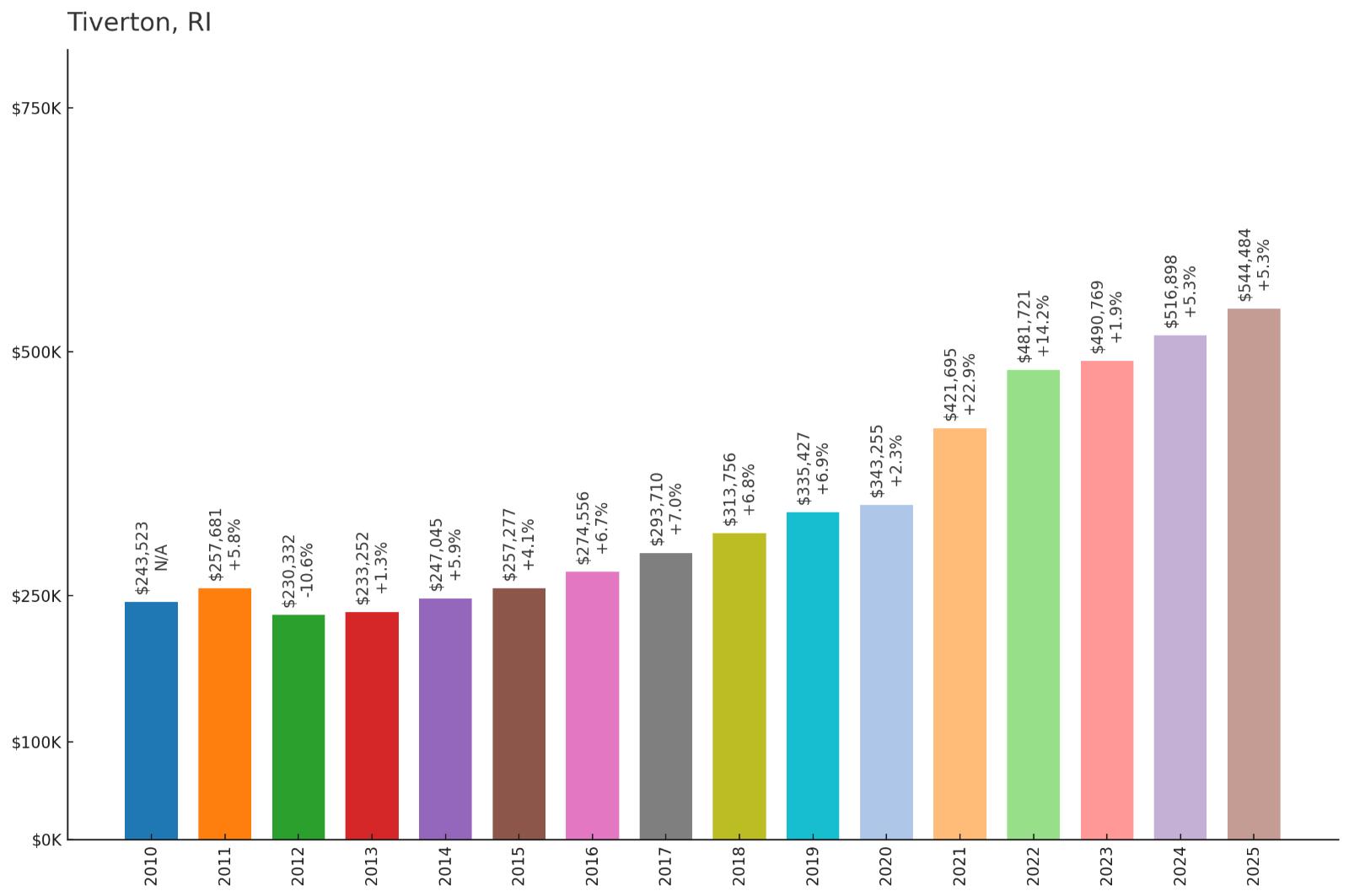
- 2010: $243,523
- 2011: $257,681
- 2012: $230,332
- 2013: $233,252
- 2014: $247,045
- 2015: $257,277
- 2016: $274,556
- 2017: $293,710
- 2018: $313,756
- 2019: $335,427
- 2020: $343,255
- 2021: $421,695
- 2022: $481,721
- 2023: $490,769
- 2024: $516,898
- 2025: $544,484
Tiverton showed strong appreciation with values climbing 124% since 2010 to reach $544,484 by 2025. The southeastern coastal town experienced steady growth with notable acceleration during 2021-2022, reflecting increased demand for its rural charm and water access. This growth pattern demonstrates sustained buyer interest in Tiverton’s unique combination of country and coastal living.
Why Tiverton?
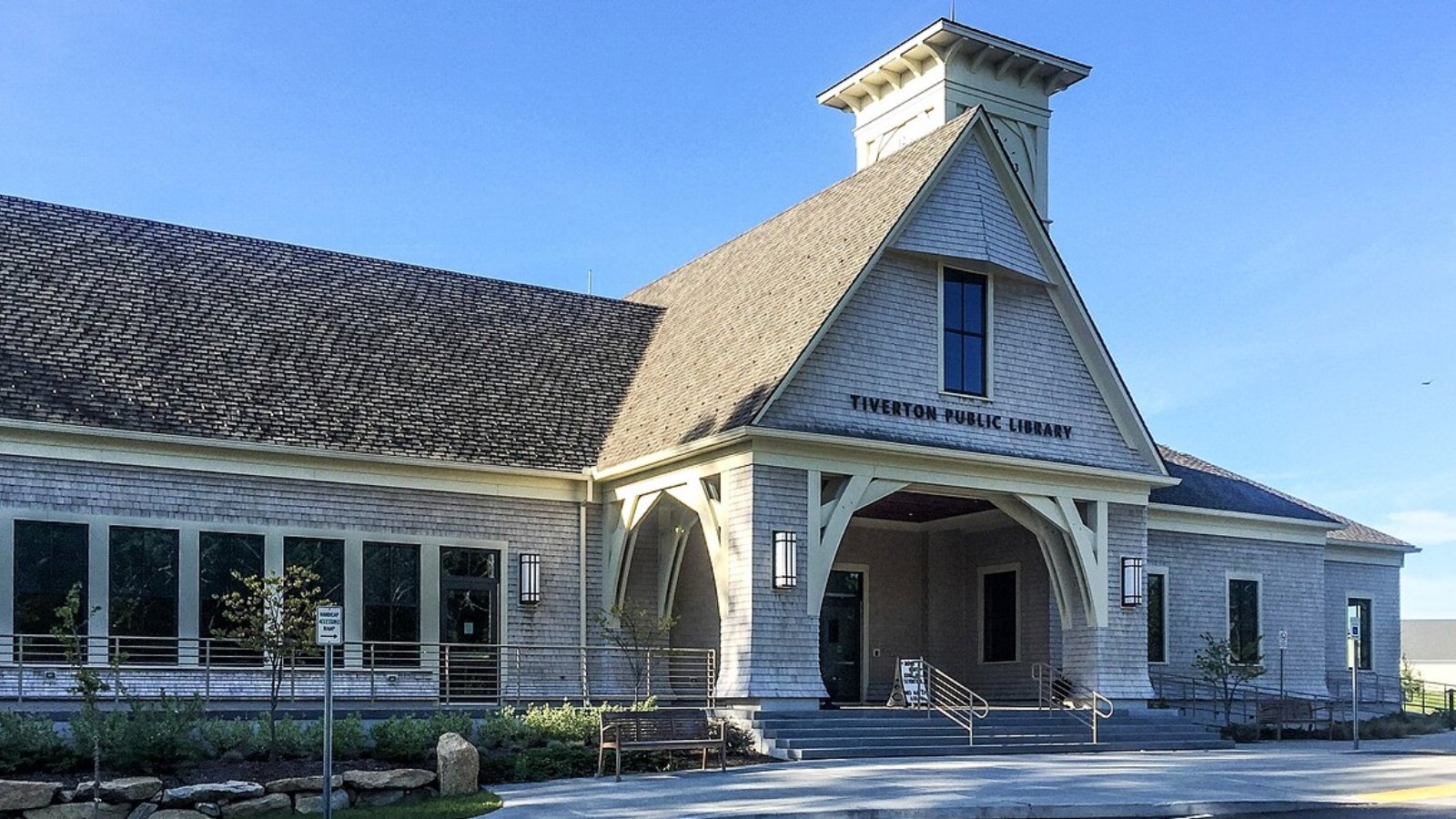
Why are people willing to pay so much to live here? What’s special about it?
Tiverton attracts buyers seeking rural tranquility with coastal access and reasonable proximity to urban amenities. The town offers working farms, historic sites, and direct access to the Sakonnet River that creates unique lifestyle opportunities. Its location provides easy access to Newport while maintaining authentic country character and lower costs.
The community features excellent schools, low crime rates, and abundant outdoor recreation including farming, fishing, and boating opportunities. Tiverton’s Four Corners area offers local shopping and dining while preserving small-town charm. This combination of rural authenticity and coastal access appeals to families and retirees seeking quality of life.
How Tiverton Rose to Prominence
Tiverton’s real estate market strengthened as buyers discovered its combination of rural charm, coastal access, and reasonable prices compared to Newport County’s more expensive areas. The town’s agricultural heritage and authentic character attracted those seeking alternatives to suburban development patterns. Strategic preservation efforts maintained the community’s essential rural appeal.
The 2010s brought increased recognition of Tiverton’s lifestyle benefits, including outdoor recreation, local farms, and water access. The town successfully balanced development pressures with conservation goals, maintaining appeal for buyers seeking authentic coastal-rural living. This approach has sustained demand while preserving the character that originally attracted residents.
3 Interesting Tidbits
1. Farm Fresh – Tiverton maintains numerous working farms, including Gray’s Ice Cream, a local institution known for dairy products and seasonal treats.
2. Stone Bridge Heritage – The historic stone bridge connecting Tiverton to Portsmouth is an iconic landmark dating to the 1920s.
3. Four Corners Hub – This historic crossroads serves as the town’s commercial center, featuring local businesses in preserved 19th-century buildings.
19. Lincoln – 87% Home Price Increase Since 2010
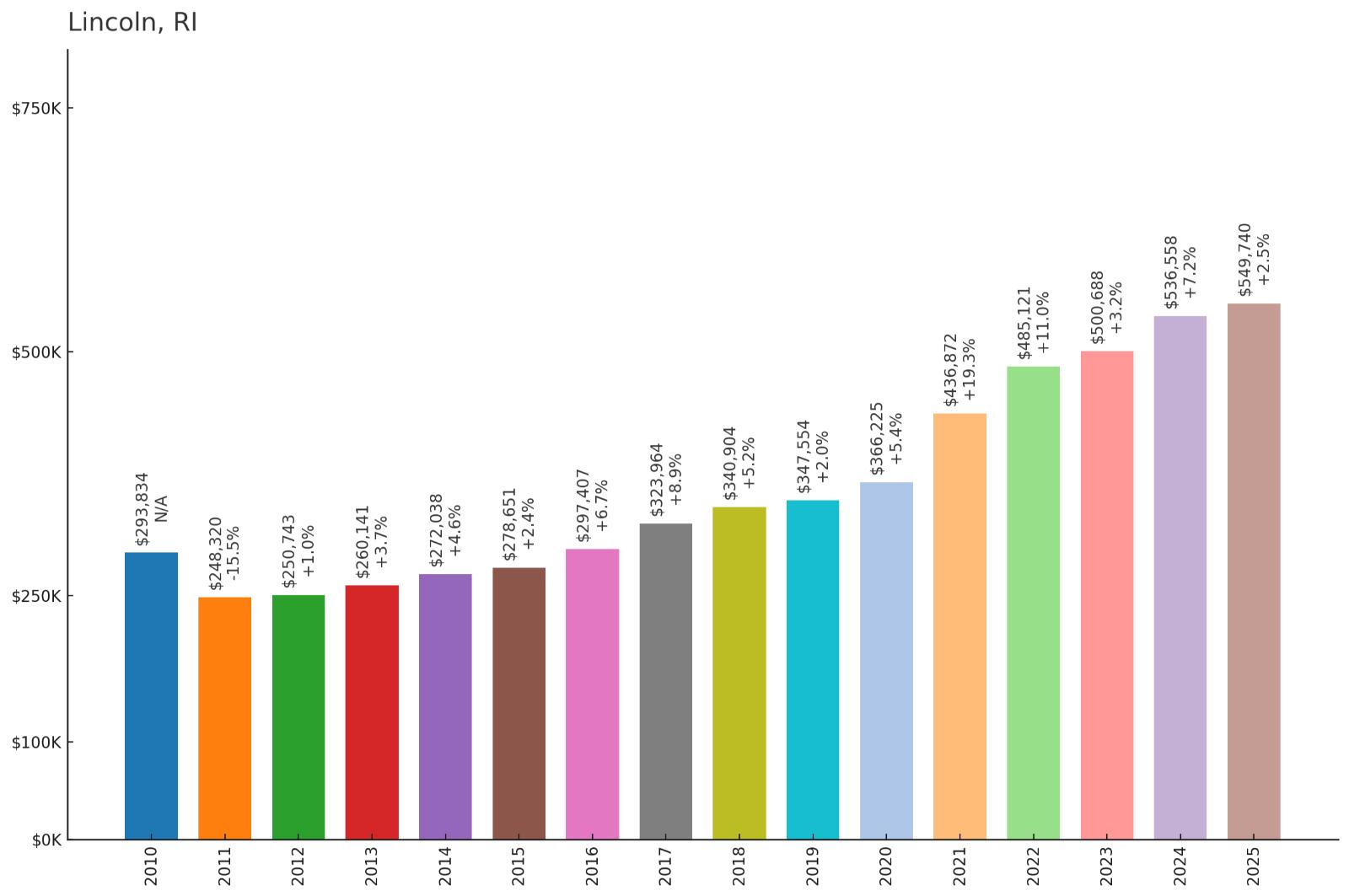
- 2010: $293,834
- 2011: $248,320
- 2012: $250,743
- 2013: $260,141
- 2014: $272,038
- 2015: $278,651
- 2016: $297,407
- 2017: $323,964
- 2018: $340,904
- 2019: $347,554
- 2020: $366,225
- 2021: $436,872
- 2022: $485,121
- 2023: $500,688
- 2024: $536,558
- 2025: $549,740
Lincoln experienced solid growth with values climbing 87% since 2010 to reach $549,740 by 2025, despite significant early-decade volatility. The northern Rhode Island town showed consistent appreciation after 2013, with acceleration during 2020-2022. This recovery demonstrates buyer confidence in Lincoln’s suburban amenities and strategic location.
Why Lincoln?
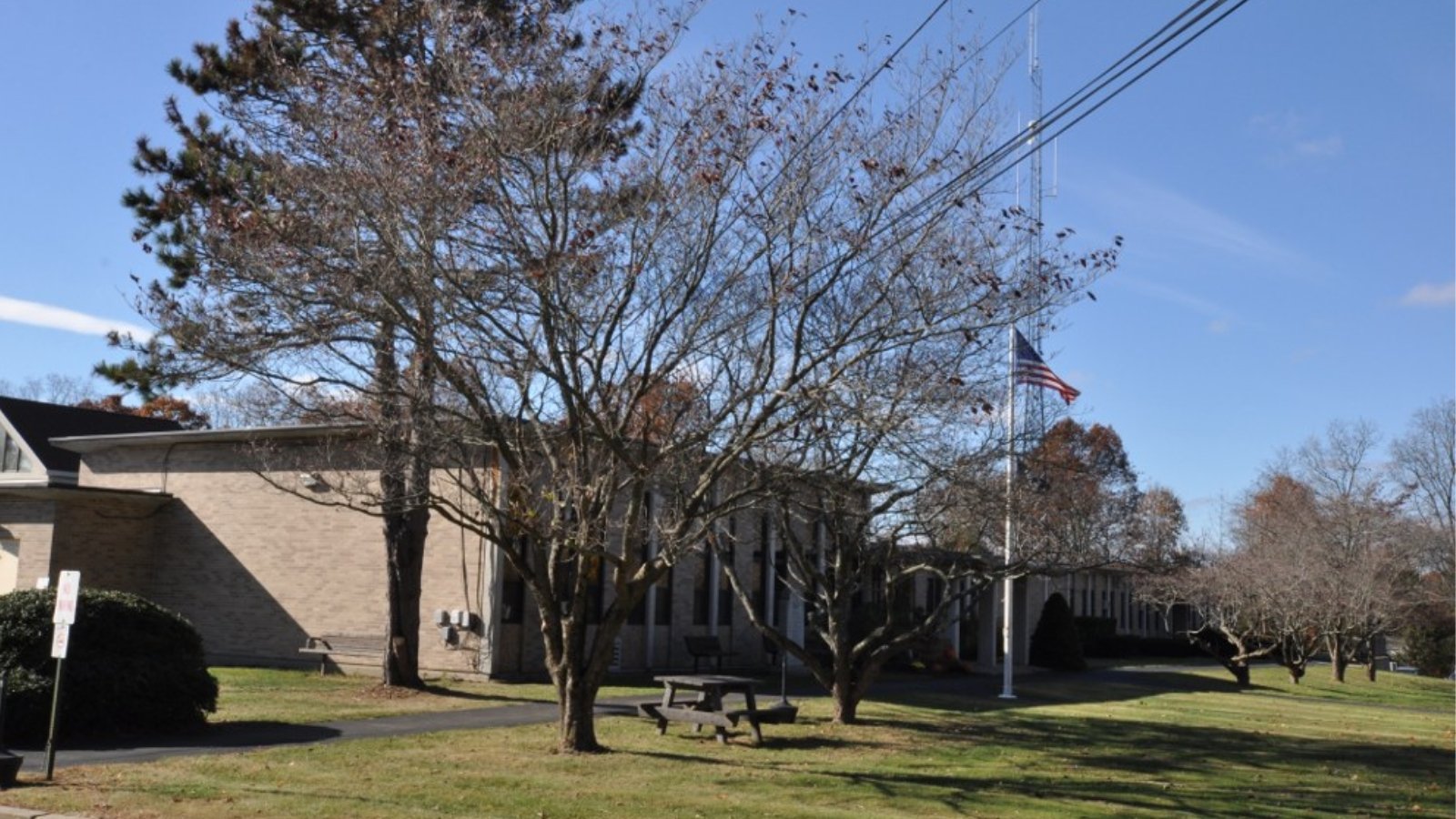
Why are people willing to pay so much to live here? What’s special about it?
Lincoln attracts families seeking suburban convenience with excellent schools, safe neighborhoods, and diverse housing options. The town offers well-established residential areas, recreational facilities, and shopping centers that meet daily needs locally. Its location provides convenient access to Providence while maintaining suburban tranquility and reasonable costs.
The community features numerous parks, sports complexes, and cultural amenities including the renowned Lincoln Woods State Park. Lincoln’s stable municipal services, good infrastructure, and strong property values make it attractive to long-term homeowners and young families. This combination of practical benefits and quality of life amenities supports continued demand.
How Lincoln Rose to Prominence
Lincoln’s development accelerated in the post-World War II era as Providence’s suburbs expanded northward. The town’s available land and strategic location attracted residential developers who built family-oriented neighborhoods and supporting commercial infrastructure. Municipal planning balanced growth with preservation of recreational assets like Lincoln Woods.
The 1980s and 1990s brought significant commercial development including shopping centers and business parks that established Lincoln as a regional employment center. This economic base, combined with good schools and recreational amenities, attracted middle-class families seeking suburban stability. The town’s consistent appeal has sustained the real estate market through various economic cycles.
3 Interesting Tidbits
1. Lincoln Woods – This popular state park within the town offers swimming, hiking, fishing, and year-round recreational opportunities for residents and visitors.
2. Mill Heritage – The historic Blackstone Valley textile mills within Lincoln have been converted to residential and commercial uses, preserving industrial heritage.
3. Twin River – The casino and entertainment complex provides jobs and tax revenue while serving as a major regional attraction.
18. Scituate – 79% Home Price Increase Since 2010
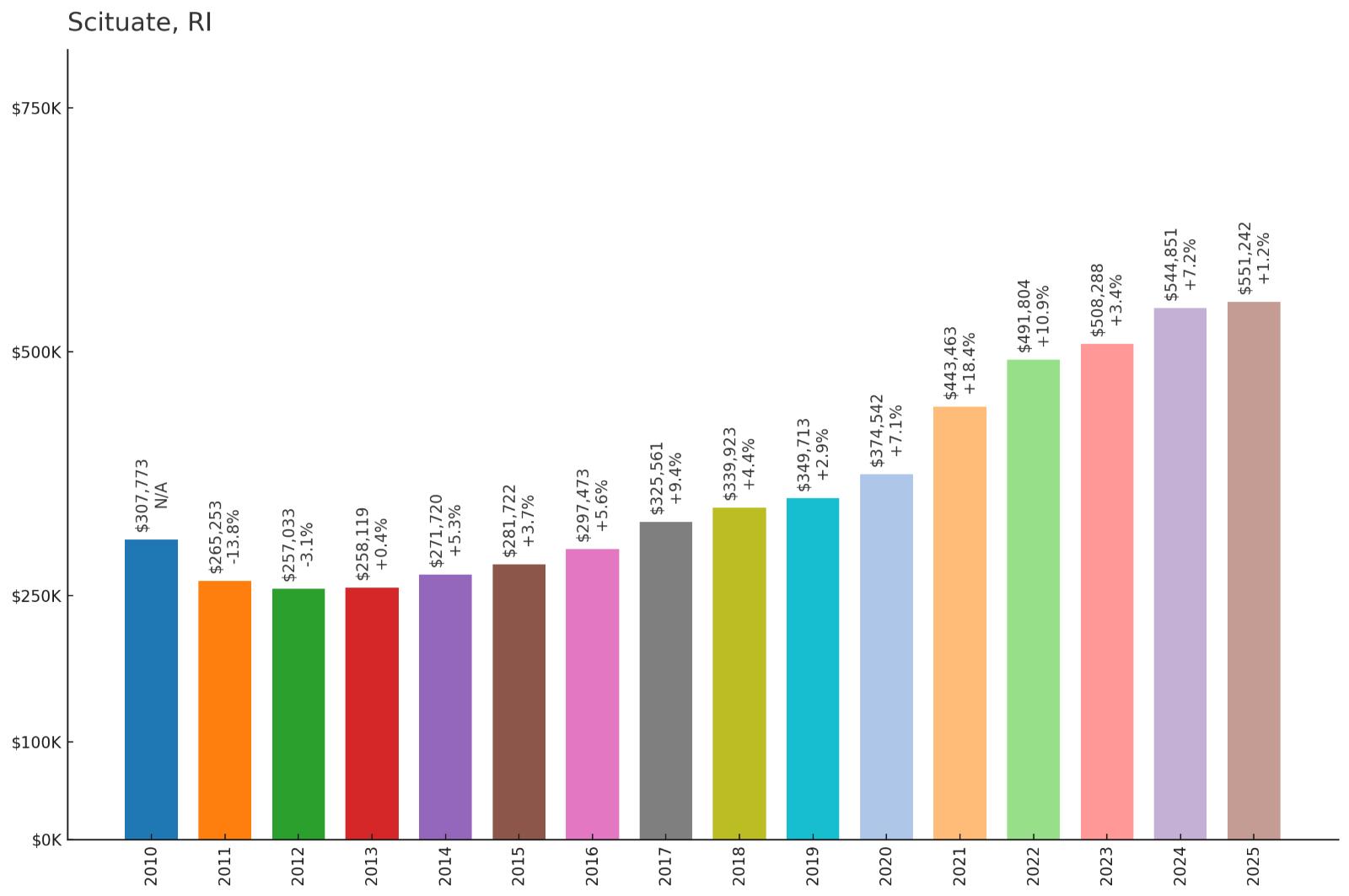
- 2010: $307,773
- 2011: $265,253
- 2012: $257,033
- 2013: $258,119
- 2014: $271,720
- 2015: $281,722
- 2016: $297,473
- 2017: $325,561
- 2018: $339,923
- 2019: $349,713
- 2020: $374,542
- 2021: $443,463
- 2022: $491,804
- 2023: $508,288
- 2024: $544,851
- 2025: $551,242
Scituate showed steady appreciation with values climbing 79% since 2010 to reach $551,242 by 2025, despite early volatility. The rural community experienced consistent growth after 2014, with notable acceleration during 2020-2022. This performance reflects buyer demand for Scituate’s large lots, natural beauty, and rural character within reasonable commuting distance.
Why Scituate?

Why are people willing to pay so much to live here? What’s special about it?
Scituate attracts buyers seeking authentic rural living with expansive properties and natural settings. The town offers large lots, custom home opportunities, and abundant forests that provide privacy and outdoor recreation. Its location maintains reasonable access to Providence while preserving genuine country character that becomes increasingly rare in Rhode Island.
The community features excellent schools, low crime rates, and the Scituate Reservoir system that creates unique natural amenities. Scituate’s conservation efforts preserve vast forest areas and water resources while maintaining the rural lifestyle that attracts residents. This combination of space, natural beauty, and municipal services supports sustained property value growth.
How Scituate Rose to Prominence
Scituate’s real estate market gained strength as buyers discovered its combination of large lots, rural character, and reasonable proximity to employment centers. The town’s role as Providence’s primary watershed created protected forests and natural areas that enhance property values while limiting development density. Strategic planning preserved essential rural character while allowing appropriate residential growth.
The 2000s brought increased recognition of Scituate’s lifestyle benefits, including outdoor recreation, privacy, and authentic country living. The town successfully balanced development pressures with conservation goals, maintaining appeal for buyers seeking space and tranquility. This approach has sustained demand while preserving the natural assets that originally attracted residents.
3 Interesting Tidbits
1. Reservoir Guardian – Scituate contains Providence’s primary water supply system, with multiple reservoirs and protected watersheds throughout the town.
2. Village Character – The historic village of North Scituate maintains authentic New England charm with local businesses and community gathering places.
3. Forest Preserve – Extensive conservation lands protect water quality while providing hiking, fishing, and nature study opportunities for residents.
17. Foster – 121% Home Price Increase Since 2010

- 2010: $256,061
- 2011: $244,581
- 2012: $242,713
- 2013: $238,316
- 2014: $262,175
- 2015: $274,093
- 2016: $288,325
- 2017: $311,055
- 2018: $332,604
- 2019: $341,098
- 2020: $356,606
- 2021: $424,756
- 2022: $477,777
- 2023: $485,025
- 2024: $523,579
- 2025: $566,644
Foster achieved impressive growth with values climbing 121% since 2010 to reach $566,644 by 2025. The rural northwestern community showed consistent upward momentum with acceleration during 2020-2022, reflecting increased demand for country properties and outdoor recreation access. This growth demonstrates buyer appreciation for Foster’s natural beauty and authentic rural character.
Why Foster?

Why are people willing to pay so much to live here? What’s special about it?
Foster attracts buyers seeking rural tranquility with extensive outdoor recreation opportunities and authentic country living. The town offers direct access to state management areas, forests, and recreational facilities that provide year-round outdoor activities. Its location near Connecticut expands recreational and cultural options while maintaining lower Rhode Island living costs.
The community features large lots, custom home opportunities, and abundant natural settings that provide privacy and peaceful living. Foster’s conservation efforts preserve forests, farms, and open spaces that enhance quality of life while supporting wildlife populations. This combination of rural authenticity and recreational access appeals to outdoor enthusiasts and families seeking space.
How Foster Rose to Prominence
Foster’s real estate market strengthened as buyers discovered its combination of affordability, natural beauty, and recreational access. The town’s location near multiple state management areas made it attractive to outdoor enthusiasts wanting country living with extensive recreational amenities. Development remained measured, preserving the community’s essential rural character.
The pandemic accelerated interest in Foster as remote work made location less critical and families prioritized space and outdoor access. The town’s recreational assets, including access to George Washington Management Area and other outdoor facilities, became increasingly valuable. This trend brought new residents while respecting the community’s rural heritage and environmental values.
3 Interesting Tidbits
1. Management Area Access – Foster provides direct access to George Washington Management Area, offering extensive hiking, camping, and outdoor recreation opportunities.
2. Historic Stone Structures – The town contains numerous historic stone walls, foundations, and structures that tell the story of early agricultural settlement.
3. Connecticut Border Benefits – Foster’s location allows residents to easily access Connecticut’s recreational areas, cultural attractions, and shopping while maintaining Rhode Island residence.
16. West Greenwich – 115% Home Price Increase Since 2010
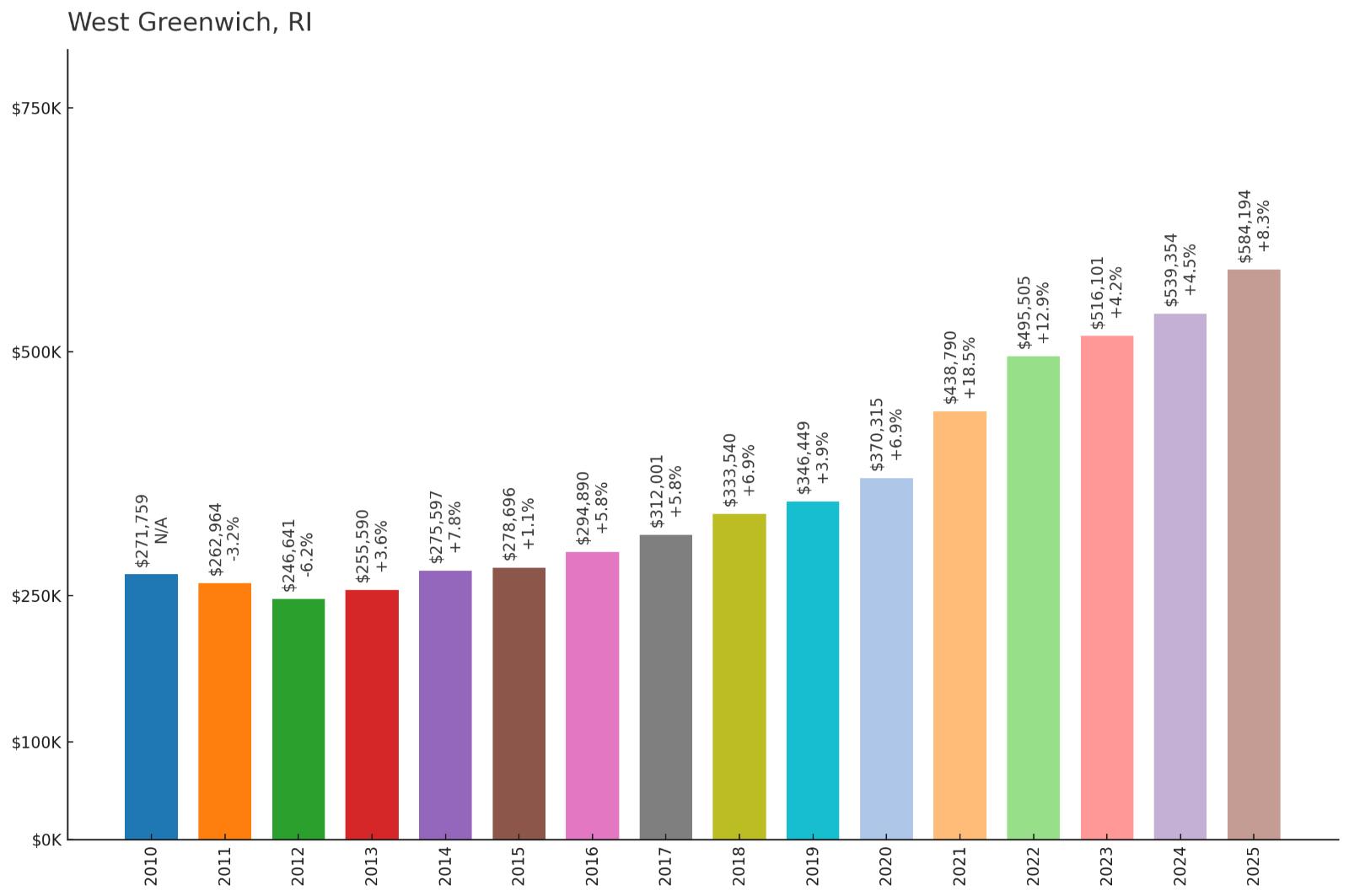
- 2010: $271,759
- 2011: $262,964
- 2012: $246,641
- 2013: $255,590
- 2014: $275,597
- 2015: $278,696
- 2016: $294,890
- 2017: $312,001
- 2018: $333,540
- 2019: $346,449
- 2020: $370,315
- 2021: $438,790
- 2022: $495,505
- 2023: $516,101
- 2024: $539,354
- 2025: $584,194
West Greenwich showed strong appreciation with values climbing 115% since 2010 to reach $584,194 by 2025. The rural southwestern community experienced steady growth with notable acceleration during 2020-2022, reflecting increased demand for country properties with recreational access. This growth pattern demonstrates sustained buyer interest in the town’s natural beauty and lifestyle benefits.
Why West Greenwich?
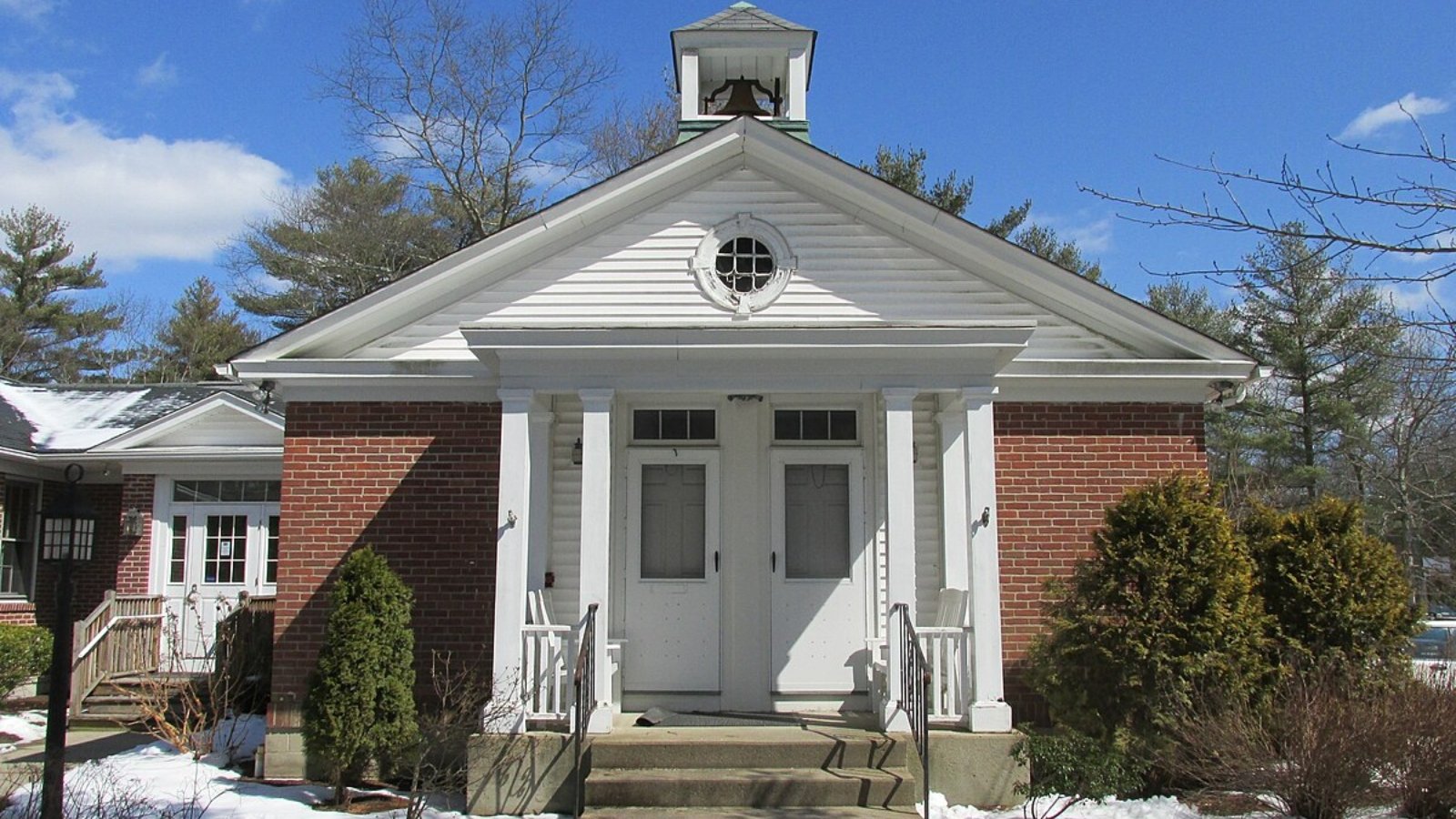
Why are people willing to pay so much to live here? What’s special about it?
West Greenwich attracts outdoor enthusiasts and families seeking rural living with extensive recreational amenities. The town offers direct access to numerous state parks, management areas, and outdoor facilities that provide year-round activities including hiking, fishing, hunting, and camping. Its location provides reasonable commutes to multiple employment centers while maintaining authentic country character.
The community features large lots, newer construction options, and abundant natural settings that create privacy and peaceful living environments. West Greenwich’s conservation efforts preserve forests and open spaces while allowing appropriate development that respects the area’s rural heritage. This balance of growth and preservation drives sustained demand and property value appreciation.
How West Greenwich Rose to Prominence
West Greenwich’s real estate market gained momentum as buyers discovered its combination of natural beauty, recreational access, and reasonable prices. The town’s proximity to popular outdoor destinations and state management areas made it attractive to families wanting country living with extensive recreational amenities. Strategic conservation efforts maintained the area’s essential rural appeal.
The 2010s brought increased attention to West Greenwich’s lifestyle benefits, including outdoor recreation, privacy, and authentic country living. The town successfully balanced development pressures with conservation goals, maintaining appeal for buyers seeking space and natural beauty. This approach has sustained demand while preserving the environmental assets that drive property values.
3 Interesting Tidbits
1. Outdoor Recreation Hub – West Greenwich provides access to multiple state management areas offering diverse outdoor recreation opportunities year-round.
2. Historic Mill Sites – Several historic mill sites and stone foundations throughout the town reflect its 18th and 19th-century industrial heritage.
3. Conservation Success – The town has preserved extensive forest lands and natural areas that provide habitat for wildlife while enhancing property values.
15. Bristol – 126% Home Price Increase Since 2010

- 2010: $262,844
- 2011: $273,256
- 2012: $281,792
- 2013: $291,168
- 2014: $306,604
- 2015: $309,518
- 2016: $322,113
- 2017: $347,519
- 2018: $364,130
- 2019: $380,483
- 2020: $390,229
- 2021: $470,324
- 2022: $523,800
- 2023: $543,577
- 2024: $592,285
- 2025: $594,413
Bristol achieved exceptional growth with values climbing 126% since 2010 to reach $594,413 by 2025. The waterfront community showed consistent upward momentum throughout the period with particularly strong gains during 2021-2022. This impressive performance reflects buyer demand for Bristol’s historic charm, waterfront access, and cultural amenities in a compact, walkable setting.
Why Bristol?
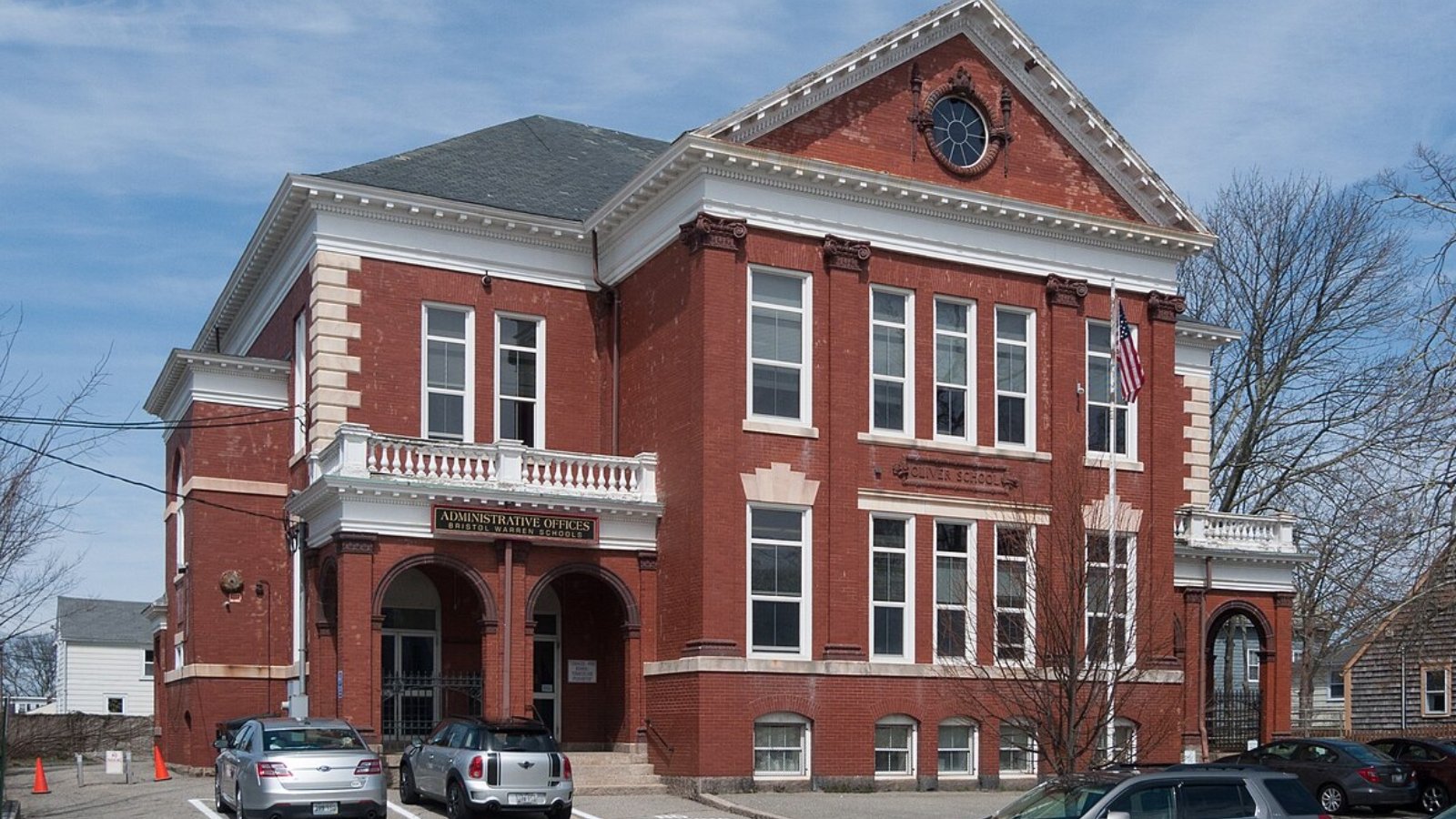
Why are people willing to pay so much to live here? What’s special about it?
Bristol attracts buyers with its authentic New England coastal charm, historic downtown, and direct waterfront access on Narragansett Bay. The town offers a walkable main street with local shops, restaurants, and cultural venues that create vibrant community life while maintaining small-town intimacy. Its waterfront location provides boating, fishing, and water recreation opportunities right in town.
The community features well-preserved historic architecture, renowned Fourth of July celebrations, and strong local traditions that create unique character and broad appeal. Bristol’s reasonable size maintains authentic community connections while offering sophisticated amenities and easy access to Providence. This combination of history, water access, and community life drives sustained buyer interest.
How Bristol Rose to Prominence
Bristol’s transformation accelerated in the 1990s as buyers discovered its combination of historic charm, waterfront access, and reasonable prices compared to Newport. The town’s well-preserved downtown and authentic maritime character attracted those seeking alternatives to more touristy coastal areas while maintaining water access and cultural amenities.
The early 2000s brought increased recognition of Bristol’s lifestyle benefits, including cultural events, local businesses, and waterfront recreation. Recent market analysis shows this quiet, waterfront town attracts those who value peaceful lifestyle and deep interest in New England history and art, with vast arrays of museums, exhibits, and monuments providing always something new to learn.
3 Interesting Tidbits
1. Fourth of July Capital – Bristol claims to host America’s oldest continuous Fourth of July celebration, dating back to 1785 with a famous parade and festivities.
2. Herreshoff Heritage – The town was home to the legendary Herreshoff Manufacturing Company, builders of eight consecutive America’s Cup-winning yachts.
3. Museum Mile – Bristol’s compact downtown features numerous museums and cultural sites within easy walking distance, creating a rich cultural experience.
14. Westerly – 96% Home Price Increase Since 2010

- 2010: $304,837
- 2011: $293,776
- 2012: $296,860
- 2013: $301,953
- 2014: $301,073
- 2015: $306,299
- 2016: $323,201
- 2017: $338,214
- 2018: $354,967
- 2019: $362,039
- 2020: $382,293
- 2021: $465,697
- 2022: $530,355
- 2023: $543,195
- 2024: $575,221
- 2025: $596,824
Westerly showed steady appreciation with values climbing 96% since 2010 to reach $596,824 by 2025. The southwestern coastal community experienced consistent growth with notable acceleration during 2020-2022, reflecting strong demand for its beach access and cultural amenities. This growth demonstrates buyer appreciation for Westerly’s combination of coastal living and vibrant downtown.
Why Westerly?
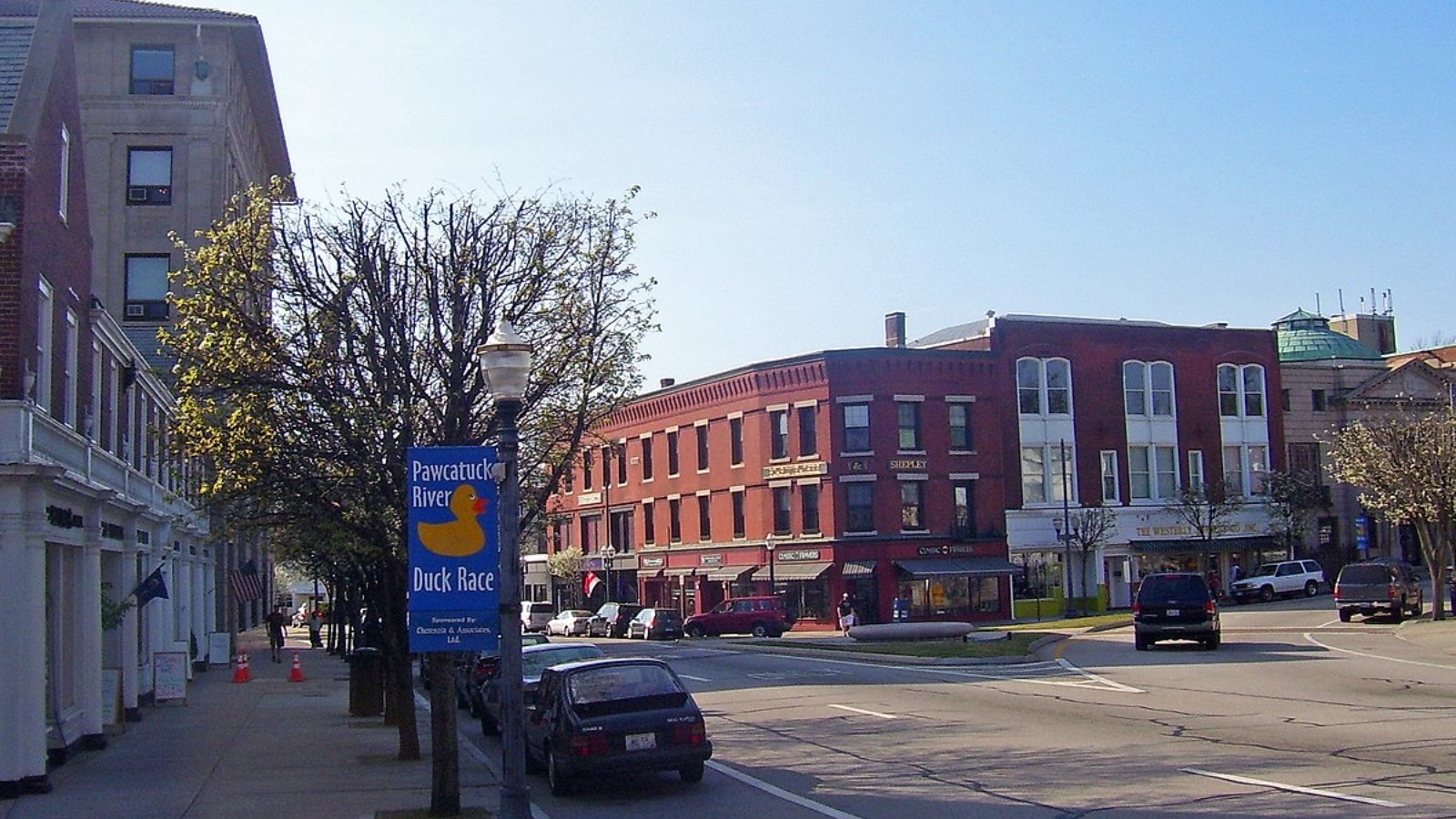
Why are people willing to pay so much to live here? What’s special about it?
Westerly attracts buyers with its combination of pristine beaches, historic downtown, and cultural sophistication that creates year-round appeal. The town offers access to Watch Hill, Misquamicut State Beach, and other premier coastal destinations while maintaining a vibrant main street with shops, restaurants, and cultural venues. Its location near Connecticut provides expanded recreational and cultural options.
The community features excellent schools, diverse housing options, and strong municipal services that appeal to families and retirees alike. Westerly’s balance of beach access, cultural amenities, and small-town charm creates broad appeal across different buyer demographics. This combination of coastal lifestyle and community sophistication drives sustained demand and property value appreciation.
How Westerly Rose to Prominence
Westerly’s real estate market strengthened as buyers discovered its combination of beach access, cultural amenities, and reasonable prices compared to more exclusive coastal areas. The town’s historic downtown and authentic New England character attracted those seeking alternatives to purely seasonal beach communities while maintaining prime coastal access.
The 2000s brought increased recognition of Westerly’s lifestyle benefits, including beaches, cultural events, and community amenities. The town successfully balanced tourism development with residential appeal, creating sustained demand for both seasonal and year-round properties. This approach has maintained appeal while supporting consistent property value growth.
3 Interesting Tidbits
1. Watch Hill Connection – The exclusive Watch Hill peninsula within Westerly features some of New England’s most prestigious summer estates and the famous flying horse carousel.
2. Cultural Hub – Downtown Westerly features numerous galleries, theaters, and cultural venues that create sophisticated small-town appeal.
3. Beach Variety – The town provides access to diverse coastal experiences from the busy Misquamicut Beach to quieter coves and nature areas.
13. Exeter – 128% Home Price Increase Since 2010
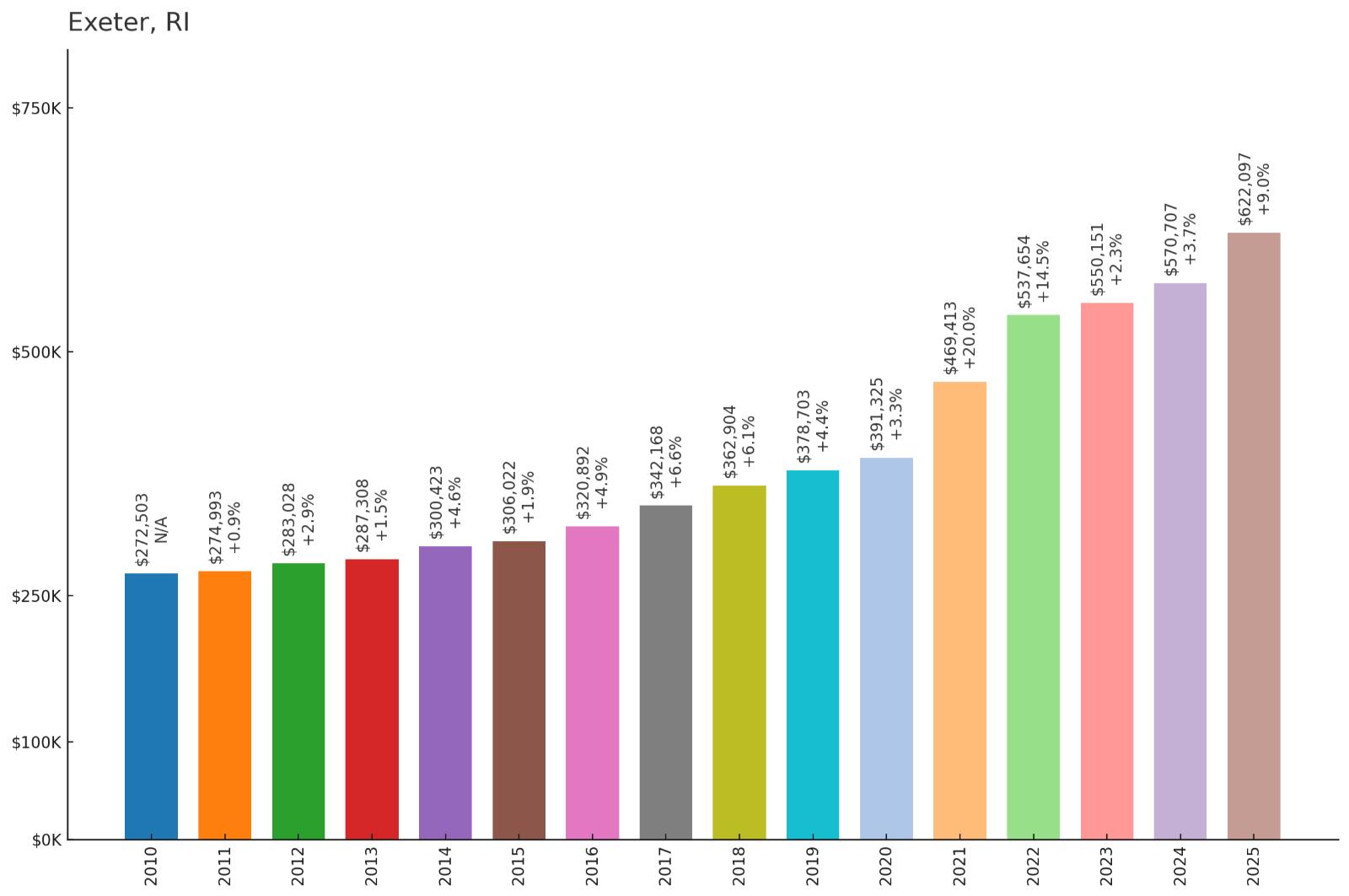
- 2010: $272,503
- 2011: $274,993
- 2012: $283,028
- 2013: $287,308
- 2014: $300,423
- 2015: $306,022
- 2016: $320,892
- 2017: $342,168
- 2018: $362,904
- 2019: $378,703
- 2020: $391,325
- 2021: $469,413
- 2022: $537,654
- 2023: $550,151
- 2024: $570,707
- 2025: $622,097
Exeter achieved impressive growth with values climbing 128% since 2010 to reach $622,097 by 2025. The rural southwestern community showed consistent upward momentum throughout the period with acceleration during 2020-2022, reflecting increased demand for country properties with recreational access. This growth demonstrates buyer appreciation for Exeter’s natural beauty and outdoor amenities.
Why Exeter?
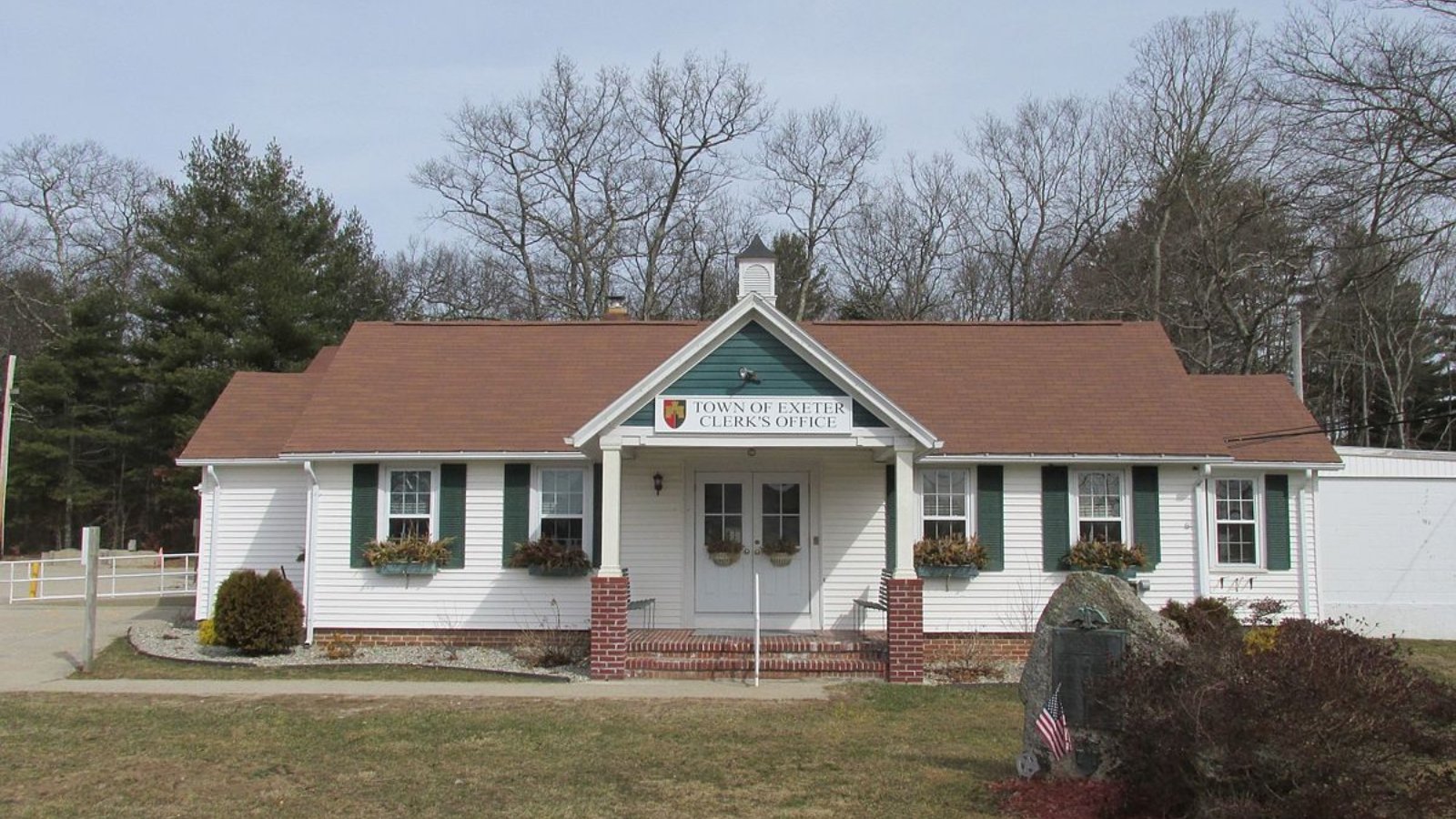
Why are people willing to pay so much to live here? What’s special about it?
Exeter attracts outdoor enthusiasts and families seeking rural living with extensive recreational opportunities. The town offers direct access to state management areas, forests, and Yawgoo Valley ski area that provide year-round outdoor activities including hiking, fishing, hunting, and skiing. Its location provides reasonable commutes while maintaining authentic country character and abundant natural beauty.
The community features large lots, custom home opportunities, and pristine natural settings that create privacy and peaceful living environments. Exeter is known for outdoor recreation, with Yawgoo Valley being Rhode Island’s only ski area located within the town borders. This combination of recreational access and rural authenticity appeals to buyers seeking space and natural beauty.
How Exeter Rose to Prominence
Exeter’s real estate market gained strength as buyers discovered its combination of natural beauty, recreational access, and affordable entry points. The town’s location near multiple state management areas and outdoor facilities made it attractive to outdoor enthusiasts wanting country living with extensive recreational amenities. Development remained measured, preserving the community’s essential rural character.
The pandemic accelerated interest in Exeter as remote work made location less critical and families prioritized space and outdoor access. The town’s recreational assets, including the Arcadia Management Area and Yawgoo Valley, became increasingly valuable to buyers seeking lifestyle amenities. This trend brought new residents while respecting the community’s rural heritage and environmental values.
3 Interesting Tidbits
1. Ski Destination – Yawgoo Valley, Rhode Island’s only ski area, operates within Exeter, providing winter recreation and economic activity.
2. Arcadia Access – The town provides direct access to the Arcadia Management Area, offering extensive hiking, camping, and outdoor recreation opportunities.
3. Rural Character – Exeter maintains working farms, forest lands, and open spaces that preserve authentic New England rural character increasingly rare in the region.
12. North Kingstown – 110% Home Price Increase Since 2010
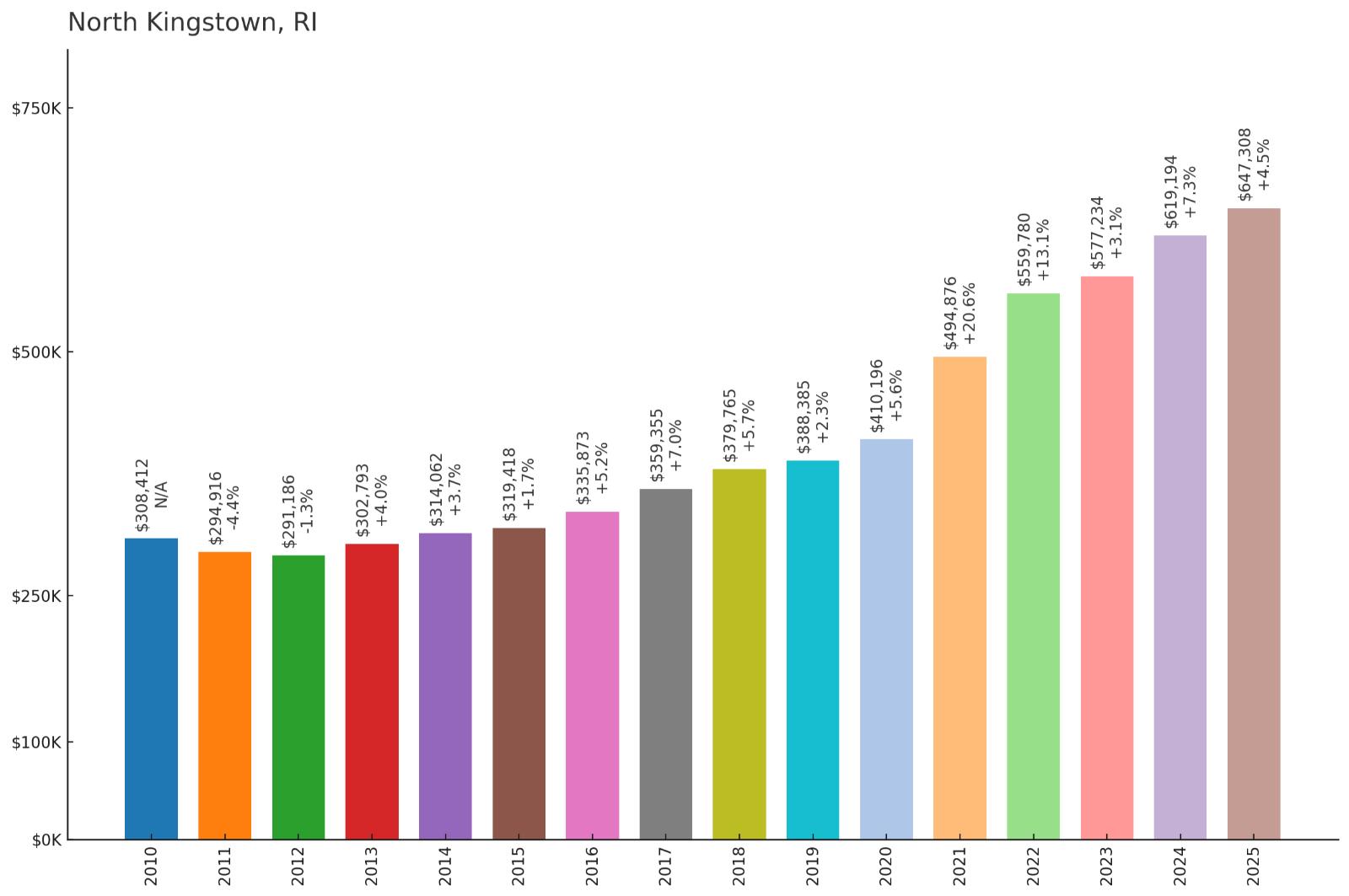
- 2010: $308,412
- 2011: $294,916
- 2012: $291,186
- 2013: $302,793
- 2014: $314,062
- 2015: $319,418
- 2016: $335,873
- 2017: $359,355
- 2018: $379,765
- 2019: $388,385
- 2020: $410,196
- 2021: $494,876
- 2022: $559,780
- 2023: $577,234
- 2024: $619,194
- 2025: $647,308
North Kingstown demonstrated strong growth with values more than doubling since 2010 to reach $647,308 by 2025. The diverse community showed consistent appreciation with acceleration during 2020-2022, reflecting demand for its combination of coastal access, suburban amenities, and historic character. This performance demonstrates broad buyer appeal across different property types and neighborhoods.
Why North Kingstown?

Why are people willing to pay so much to live here? What’s special about it?
North Kingstown attracts buyers with its diverse neighborhoods ranging from coastal areas to suburban subdivisions and historic villages. The town offers excellent schools, numerous recreational facilities, and easy access to beaches and Narragansett Bay while maintaining reasonable commutes to Providence and other employment centers. Its variety of housing options appeals to different buyer preferences and budgets.
The community features Quonset Point business park, historic Wickford village, and numerous parks and recreational facilities that create economic stability and quality of life benefits. North Kingstown’s balance of residential neighborhoods, commercial development, and preserved open spaces provides comprehensive community amenities. This diversity and stability drive sustained buyer interest and property value appreciation.
How North Kingstown Rose to Prominence
North Kingstown’s growth accelerated in the 1980s and 1990s as families discovered its combination of suburban amenities, coastal access, and reasonable prices. The town’s diverse neighborhoods and excellent schools attracted middle-class families seeking quality of life benefits within commuting distance of Providence and Newport.
The development of Quonset Point as a business park and the preservation of historic Wickford village created economic anchors that supported residential growth. The town successfully balanced development with preservation, maintaining community character while adding amenities and infrastructure. This approach has sustained appeal across different buyer demographics and economic cycles.
3 Interesting Tidbits
1. Wickford Village – This historic waterfront village features 18th-century architecture, boutique shops, and restaurants that create unique charm and tourist appeal.
2. Quonset Point – The former naval air station has been transformed into a major business park providing jobs and economic stability for the community.
3. Gilbert Stuart Birthplace – The town preserves the birthplace and studio of Gilbert Stuart, the artist famous for his portraits of George Washington.
11. Portsmouth – 105% Home Price Increase Since 2010

- 2010: $329,892
- 2011: $350,017
- 2012: $307,681
- 2013: $321,084
- 2014: $330,583
- 2015: $334,389
- 2016: $350,578
- 2017: $375,109
- 2018: $400,763
- 2019: $410,975
- 2020: $421,716
- 2021: $527,867
- 2022: $600,705
- 2023: $614,239
- 2024: $649,764
- 2025: $675,137
Portsmouth showed strong appreciation with values more than doubling since 2010 to reach $675,137 by 2025. The Aquidneck Island community experienced steady growth with notable acceleration during 2020-2022, reflecting demand for its rural character and island location. This performance demonstrates buyer interest in Portsmouth’s combination of space, natural beauty, and strategic location.
Why Portsmouth?

Why are people willing to pay so much to live here? What’s special about it?
Portsmouth attracts buyers seeking rural tranquility with island charm and easy access to Newport’s amenities. The town offers large lots, agricultural lands, and preserved open spaces that create authentic country living on prestigious Aquidneck Island. Its location provides the benefits of island living while maintaining reasonable access to urban centers and cultural attractions.
The community features excellent schools, low crime rates, and numerous recreational facilities including parks, farms, and waterfront areas. Portsmouth’s balance of rural character and modern conveniences appeals to families and professionals seeking space and quality of life. This combination of island prestige and practical benefits drives sustained demand and property value growth.
How Portsmouth Rose to Prominence
Portsmouth’s real estate market strengthened as buyers discovered its combination of rural character, island location, and reasonable prices compared to Newport. The town’s agricultural heritage and preserved open spaces attracted those seeking alternatives to suburban development while maintaining prestigious Aquidneck Island address.
The 2000s brought increased recognition of Portsmouth’s lifestyle benefits, including space, privacy, and access to island amenities. The town successfully balanced development pressures with conservation goals, maintaining rural appeal while allowing appropriate residential growth. This approach has sustained demand while preserving the character that originally attracted buyers.
3 Interesting Tidbits
1. Green Animals – This unique topiary garden features elaborate sculpted bushes and remains one of Portsmouth’s most distinctive tourist attractions.
2. Agricultural Heritage – Several working farms continue operating in Portsmouth, maintaining the town’s rural character and providing local agricultural products.
3. Island Advantage – Portsmouth combines rural living with island prestige and easy access to Newport’s cultural attractions and amenities.
10. South Kingstown – 114% Home Price Increase Since 2010
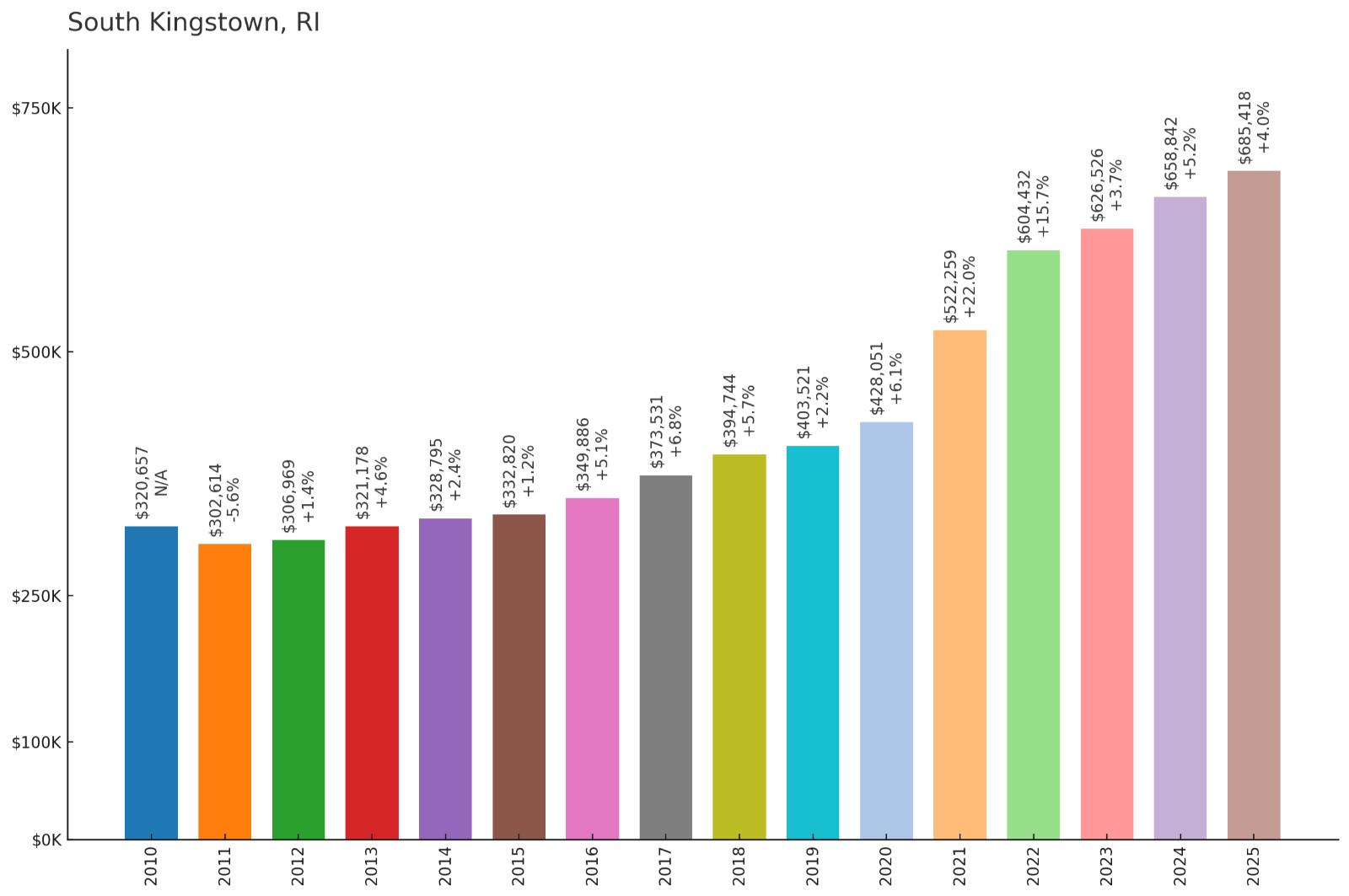
- 2010: $320,657
- 2011: $302,614
- 2012: $306,969
- 2013: $321,178
- 2014: $328,795
- 2015: $332,820
- 2016: $349,886
- 2017: $373,531
- 2018: $394,744
- 2019: $403,521
- 2020: $428,051
- 2021: $522,259
- 2022: $604,432
- 2023: $626,526
- 2024: $658,842
- 2025: $685,418
South Kingstown achieved strong growth with values climbing 114% since 2010 to reach $685,418 by 2025. The diverse coastal community showed consistent appreciation with acceleration during 2020-2022, reflecting demand for its combination of beach access, university presence, and varied neighborhoods. This performance demonstrates broad buyer appeal across different property types and demographics.
Why South Kingstown?

Why are people willing to pay so much to live here? What’s special about it?
South Kingstown attracts buyers with its diverse offerings including coastal areas, suburban neighborhoods, and rural sections that provide options for different lifestyles and budgets. The town features excellent beaches, the University of Rhode Island campus, and historic villages that create year-round appeal and economic stability. Its location provides easy access to beaches while maintaining reasonable commutes to Providence and other employment centers.
The community offers excellent schools, numerous recreational facilities, and cultural amenities enhanced by URI’s presence. South Kingstown’s variety of neighborhoods from beachfront properties to suburban subdivisions and rural areas appeals to diverse buyer preferences. This comprehensive appeal across different demographics and price points drives sustained demand and property value appreciation.
How South Kingstown Rose to Prominence
South Kingstown’s growth accelerated in the 1980s and 1990s as families discovered its combination of beach access, university amenities, and diverse housing options. The town’s varied neighborhoods and excellent schools attracted middle-class families seeking coastal lifestyle benefits within reasonable budgets. URI’s presence provided economic stability and cultural enrichment.
The 2000s brought increased recognition of South Kingstown’s comprehensive appeal, including beaches, education, and community amenities. The town successfully balanced coastal development with inland preservation, maintaining appeal across different buyer segments. This diverse approach has sustained demand while supporting consistent property value growth across various neighborhoods and property types.
3 Interesting Tidbits
1. URI Campus – The University of Rhode Island’s main campus provides educational opportunities, cultural events, and economic stability that enhance community appeal.
2. Beach Variety – South Kingstown offers access to multiple beaches including popular Scarborough State Beach and quieter neighborhood coastal areas.
3. Historic Villages – The town contains several historic villages including Wakefield and Peace Dale, each with distinct character and local businesses.
9. Charlestown – 127% Home Price Increase Since 2010
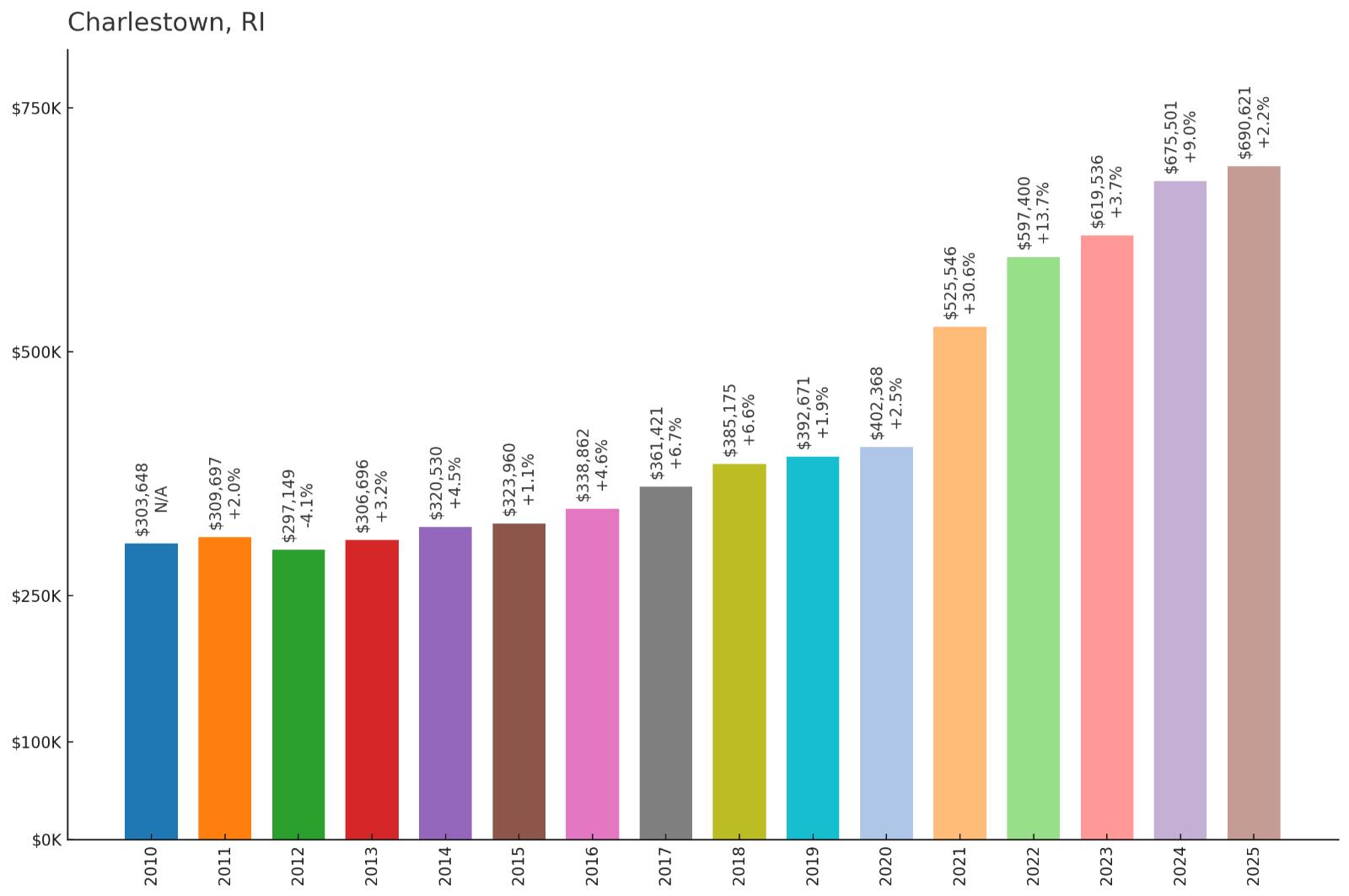
- 2010: $303,648
- 2011: $309,697
- 2012: $297,149
- 2013: $306,696
- 2014: $320,530
- 2015: $323,960
- 2016: $338,862
- 2017: $361,421
- 2018: $385,175
- 2019: $392,671
- 2020: $402,368
- 2021: $525,546
- 2022: $597,400
- 2023: $619,536
- 2024: $675,501
- 2025: $690,621
Charlestown delivered impressive growth with values climbing 127% since 2010 to reach $690,621 by 2025. The coastal community showed steady appreciation with dramatic acceleration after 2020, reflecting intense demand for its pristine beaches and natural beauty. This exceptional performance demonstrates buyer willingness to pay premiums for Charlestown’s unique combination of coastal access and environmental preservation.
Why Charlestown?

Why are people willing to pay so much to live here? What’s special about it?
Charlestown attracts buyers with its spectacular undeveloped coastline, state beaches, and extensive conservation lands that create unparalleled natural beauty. The town offers direct access to some of Rhode Island’s finest beaches while maintaining rural character through careful development controls. Its location provides coastal living with authentic New England charm and abundant outdoor recreation opportunities.
The community features pristine natural environments, low crime rates, and strong conservation ethic that preserves the area’s essential character. Charlestown’s commitment to environmental protection ensures that development remains compatible with natural assets, supporting long-term property values. This balance of coastal access and environmental stewardship appeals to buyers seeking sustainable coastal living.
How Charlestown Rose to Prominence
Charlestown’s real estate market gained momentum as buyers discovered its combination of pristine beaches, natural beauty, and reasonable prices compared to more developed coastal areas. The town’s commitment to conservation and controlled development attracted those seeking authentic coastal living without commercial tourism pressures.
The 2010s brought increased recognition of Charlestown’s environmental assets, including state beaches, wildlife refuges, and preserved coastal areas. The town successfully balanced development pressures with conservation goals, maintaining appeal for buyers seeking natural beauty and coastal access. This approach has sustained demand while preserving the environmental quality that drives property values.
3 Interesting Tidbits
1. Beach Paradise – Charlestown contains several pristine state beaches including Charlestown Beach and Burlingame State Park beach areas.
2. Conservation Leader – The town has preserved extensive coastal and inland areas through conservation easements and land acquisition programs.
3. Wildlife Haven – Charlestown’s diverse habitats support numerous wildlife species, making it popular for nature observation and outdoor recreation.
8. Middletown – 123% Home Price Increase Since 2010
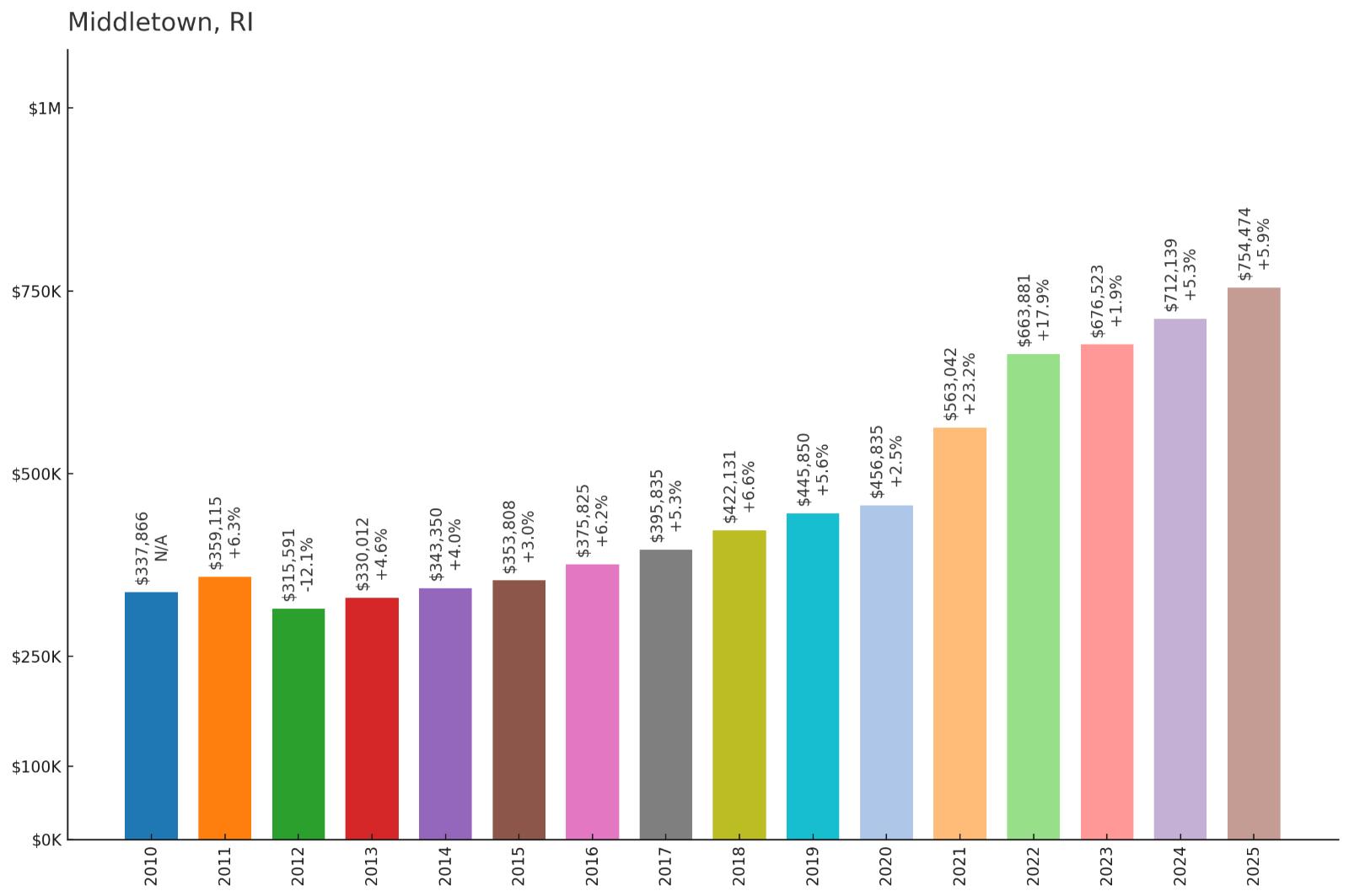
- 2010: $337,866
- 2011: $359,115
- 2012: $315,591
- 2013: $330,012
- 2014: $343,350
- 2015: $353,808
- 2016: $375,825
- 2017: $395,835
- 2018: $422,131
- 2019: $445,850
- 2020: $456,835
- 2021: $563,042
- 2022: $663,881
- 2023: $676,523
- 2024: $712,139
- 2025: $754,474
Middletown achieved impressive growth with values climbing 123% since 2010 to reach $754,474 by 2025. Located on Aquidneck Island, the community showed consistent appreciation with notable acceleration during 2020-2022, reflecting strong demand for its combination of beach access and island living. This performance demonstrates buyer interest in Middletown’s unique position between Newport’s excitement and Portsmouth’s tranquility.
Why Middletown?

Why are people willing to pay so much to live here? What’s special about it?
Middletown bridges the bustle of Newport and the rural calm of Portsmouth, offering beach access, vineyards, and sweeping Atlantic views often at more accessible prices than neighboring Newport. The town is known for Second Beach, Sachuest Point, and residential areas that attract both families and retirees seeking coastal living with space and serenity. Its appeal lies in balancing convenience with coastal beauty and lower density development.
The community offers excellent schools, recreational facilities, and direct access to some of Rhode Island’s most beautiful beaches while maintaining reasonable proximity to Newport’s cultural attractions. As Newport’s housing prices have climbed, Middletown has absorbed overflow demand, boosting its own property values. This unique positioning continues to drive real estate market growth.
How Middletown Rose to Prominence
Middletown’s transformation accelerated as buyers discovered its combination of island prestige, beach access, and reasonable prices compared to Newport. The town’s strategic location on Aquidneck Island provided coastal lifestyle benefits while maintaining more space and lower costs than its famous neighbor.
The 2000s brought increased recognition of Middletown’s lifestyle benefits, including beaches, golf courses, and island amenities. Market analysis shows the town places fifth among Rhode Island’s most expensive communities, with homes selling for an average of nearly $980,000 in recent years. The community successfully marketed itself as offering island living with modern conveniences and natural beauty.
3 Interesting Tidbits
1. Second Beach – This pristine beach consistently ranks among New England’s finest, offering excellent surfing and swimming conditions.
2. Vineyard Country – Middletown features several wineries and vineyards that add agricultural charm and tourist appeal to the community.
3. Sachuest Point – This National Wildlife Refuge within the town provides hiking trails and wildlife viewing opportunities along dramatic coastal cliffs.
7. Barrington – 136% Home Price Increase Since 2010
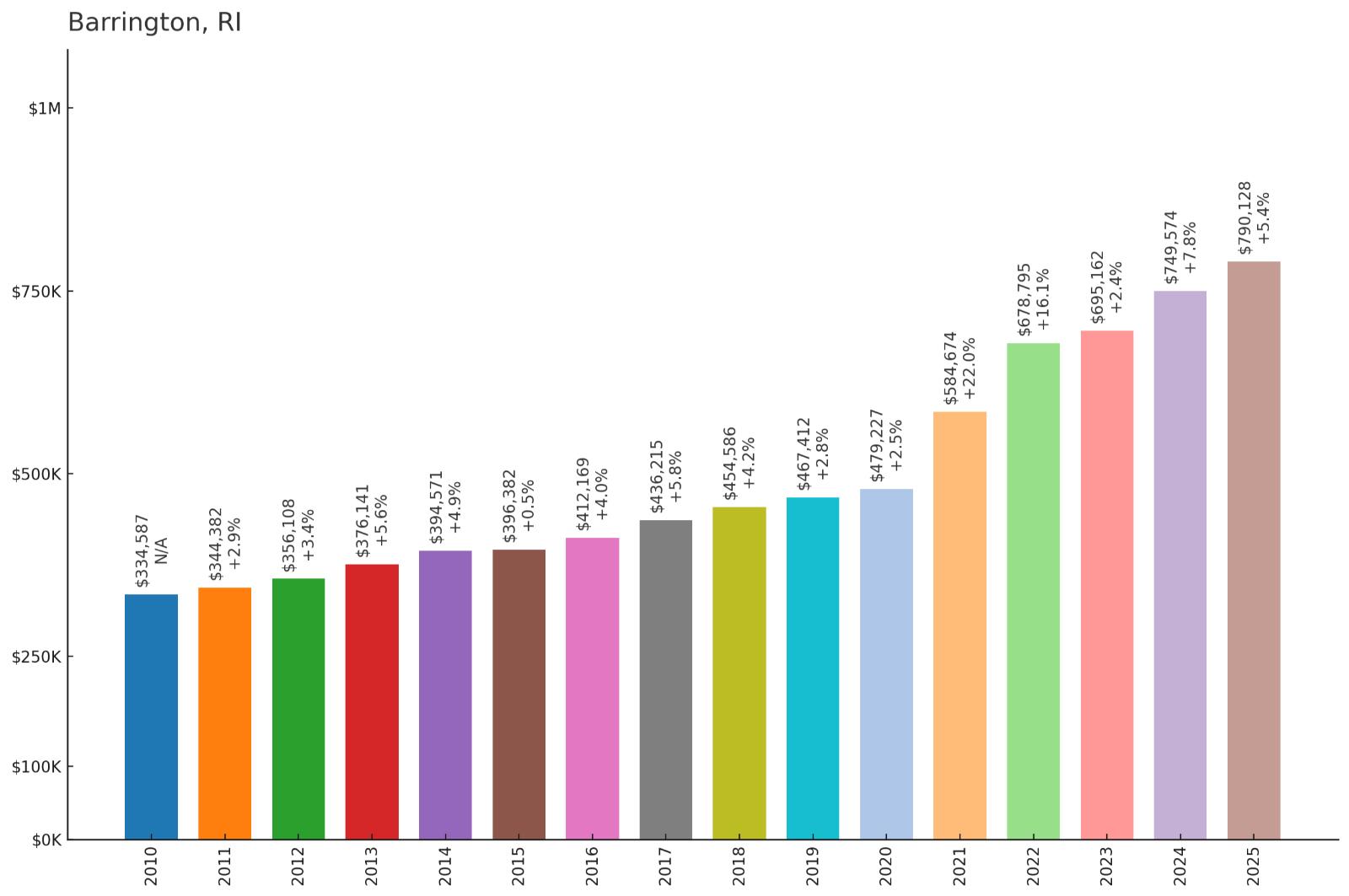
- 2010: $334,587
- 2011: $344,382
- 2012: $356,108
- 2013: $376,141
- 2014: $394,571
- 2015: $396,382
- 2016: $412,169
- 2017: $436,215
- 2018: $454,586
- 2019: $467,412
- 2020: $479,227
- 2021: $584,674
- 2022: $678,795
- 2023: $695,162
- 2024: $749,574
- 2025: $790,128
Barrington delivered exceptional growth with values climbing 136% since 2010 to reach $790,128 by 2025. This East Bay community showed consistent upward momentum throughout the period with particularly strong gains during 2021-2022, reflecting intense demand for its premier suburban amenities and waterfront location. The impressive performance demonstrates buyer willingness to pay premiums for Barrington’s combination of excellent schools and coastal access.
Why Barrington?

Why are people willing to pay so much to live here? What’s special about it?
Barrington attracts affluent families with its exceptional schools, prime waterfront location, and prestigious suburban character positioned on a peninsula with Narragansett Bay views. The town consistently ranks as Rhode Island’s premier suburb, with distinguished neighborhoods like Rumstick Point offering grand estates while the vibrant town center adds community charm. Its proximity to Providence supports continued high demand from affluent professionals seeking top-tier amenities.
The community features some of the state’s highest-performing schools, low crime rates, and abundant recreational opportunities including boating, waterfront parks, and cultural events. Barrington’s careful development and municipal services maintain property values while preserving the suburban character that originally attracted residents. This combination of educational excellence and waterfront prestige drives sustained premium pricing.
How Barrington Rose to Prominence
Barrington’s transformation into Rhode Island’s premier suburb began in the mid-20th century as affluent families discovered its combination of excellent schools, waterfront access, and reasonable commutes to Providence. The town’s strategic location on the East Bay provided coastal lifestyle benefits while maintaining suburban conveniences.
The 1980s and 1990s established Barrington’s reputation for educational excellence and municipal services that attracted upper-middle-class families. Recent market analysis shows the town’s exceptional schools and prime waterfront location have driven significant appreciation, with values surpassing previous highs. The community successfully maintained its exclusive character while supporting continued development that respects established neighborhoods.
3 Interesting Tidbits
1. Rumstick Point – This exclusive waterfront neighborhood features grand estates with spectacular bay views and represents some of Barrington’s most prestigious properties.
2. Educational Excellence – Barrington’s school system consistently ranks among Rhode Island’s finest, driving significant residential demand from families prioritizing education.
3. Bay Access – The town’s peninsula location provides extensive waterfront access, boating opportunities, and scenic beauty that enhance property values.
6. East Greenwich – 96% Home Price Increase Since 2010
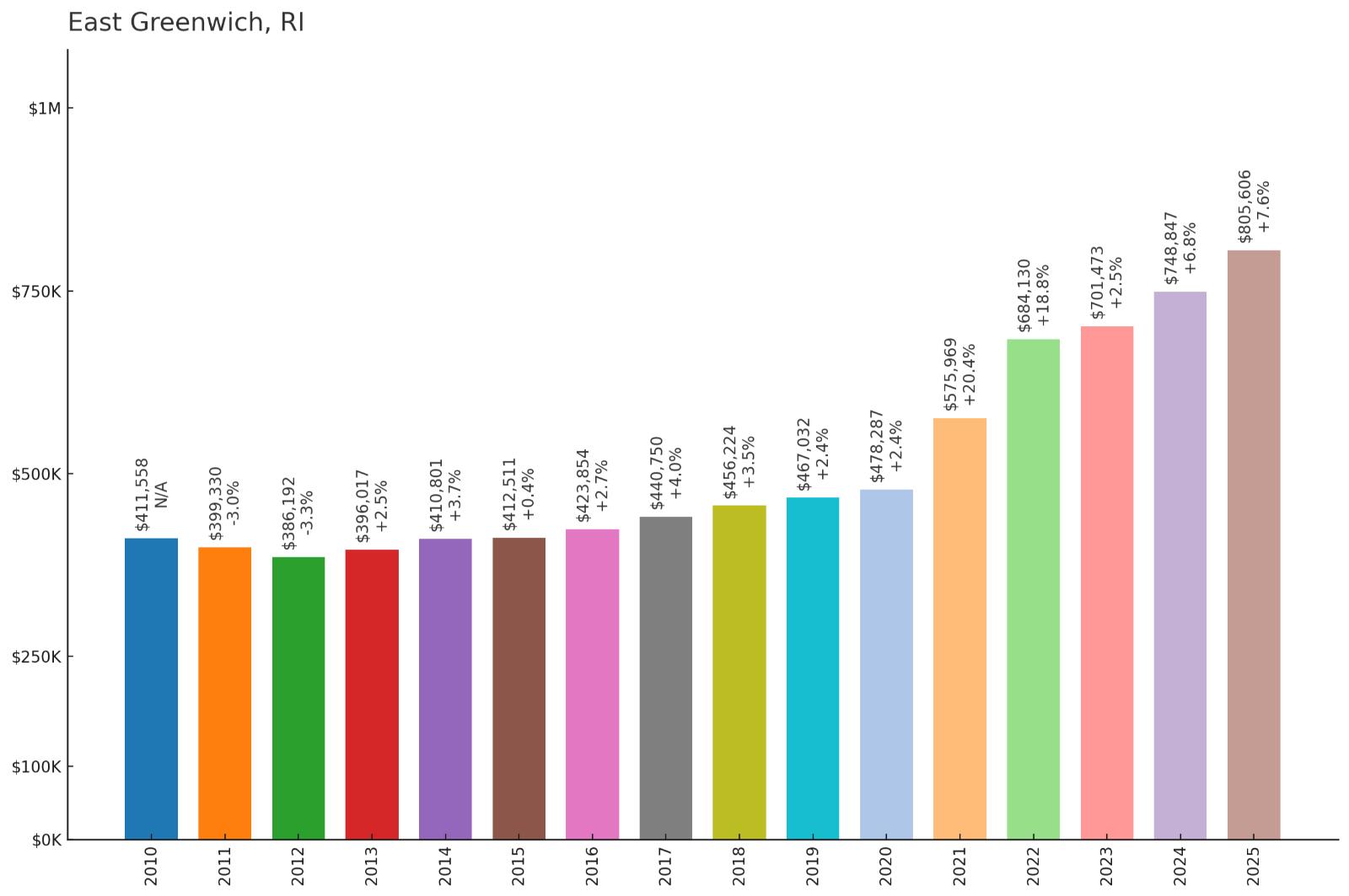
- 2010: $411,558
- 2011: $399,330
- 2012: $386,192
- 2013: $396,017
- 2014: $410,801
- 2015: $412,511
- 2016: $423,854
- 2017: $440,750
- 2018: $456,224
- 2019: $467,032
- 2020: $478,287
- 2021: $575,969
- 2022: $684,130
- 2023: $701,473
- 2024: $748,847
- 2025: $805,606
East Greenwich showed solid appreciation with values climbing 96% since 2010 to reach $805,606 by 2025, starting from the highest 2010 baseline among all towns. This historic Kent County community experienced steady growth with acceleration during 2020-2022, reflecting sustained demand for its combination of historic charm, excellent schools, and strategic location. The strong performance demonstrates continued buyer confidence in East Greenwich’s premium suburban appeal.
Why East Greenwich?

Why are people willing to pay so much to live here? What’s special about it?
East Greenwich attracts affluent buyers with its historic harbor, hillside neighborhoods, and upscale amenities that create sophisticated small-town appeal. The community offers boutique shops and dining along Main Street while balancing historic charm with modern conveniences. Desirable neighborhoods like Westwood and Frenchtown provide suburban tranquility near employment hubs with easy access to Providence and Newport.
The town features excellent schools, well-preserved historic architecture, and numerous recreational amenities including parks, harbor access, and cultural venues. East Greenwich’s municipal services, infrastructure, and strategic planning maintain the community character that attracts long-term residents. This combination of historic preservation and modern amenities justifies premium pricing and sustained demand.
How East Greenwich Rose to Prominence
East Greenwich established its reputation as a premier Rhode Island community through careful preservation of historic assets combined with strategic development. The town’s colonial heritage and harbor location provided authentic New England character while modern amenities and excellent schools attracted affluent families.
The late 20th century brought recognition of East Greenwich as one of Rhode Island’s most desirable communities, with historic buildings, friendly atmosphere, and beautiful scenery. Market analysis shows the town’s historic harbor and upscale amenities have driven consistent appreciation over the past decade. The town successfully balanced preservation with growth, maintaining appeal across different buyer demographics.
3 Interesting Tidbits
1. Historic Main Street – The well-preserved downtown features colonial and Victorian architecture housing contemporary shops, restaurants, and cultural venues.
2. Harbor Heritage – East Greenwich’s harbor area maintains its maritime character while serving as a focal point for community events and waterfront recreation.
3. Revolutionary History – The town played significant roles in the Revolutionary War, with numerous historic sites and buildings preserved from that era.
5. Narragansett – 151% Home Price Increase Since 2010

- 2010: $333,380
- 2011: $334,901
- 2012: $335,602
- 2013: $347,715
- 2014: $357,239
- 2015: $368,202
- 2016: $387,155
- 2017: $407,125
- 2018: $431,484
- 2019: $455,652
- 2020: $470,257
- 2021: $611,152
- 2022: $705,147
- 2023: $732,001
- 2024: $759,002
- 2025: $835,748
Narragansett delivered outstanding growth with values climbing 151% since 2010 to reach $835,748 by 2025. The coastal community showed remarkable acceleration after 2020, jumping from $470,257 to over $835,000 today. This exceptional performance reflects intense buyer demand for Narragansett’s spectacular beaches, coastal scenery, and seaside lifestyle.
Why Narragansett?

Why are people willing to pay so much to live here? What’s special about it?
Narragansett’s spectacular beaches and iconic coastal scenery attract buyers seeking quintessential seaside living with year-round appeal. The town offers pristine beaches like Narragansett Town Beach and Scarborough State Beach, along with the charming Pier area that creates vibrant waterfront activity. Neighborhoods range from grand oceanfront estates in Bonnet Shores to accessible properties near the University of Rhode Island.
The community provides perfect blend of natural beauty and modern amenities that secure consistent growth and appeal. Narragansett’s coastal location offers surfing, swimming, fishing, and beach activities while maintaining authentic seaside character. The town’s proximity to URI adds educational and cultural value while supporting diverse housing options that appeal to various buyer demographics.
How Narragansett Rose to Prominence
Narragansett’s transformation from summer resort to year-round destination began in the late 20th century as buyers discovered its combination of beach access, reasonable prices, and authentic coastal character. The town’s famous pier area and beach communities attracted those seeking alternatives to more expensive coastal areas while maintaining prime oceanfront access.
The 2000s brought increased recognition of Narragansett as a premier coastal destination offering both seasonal tourism and year-round living appeal. Market research shows the town’s spectacular beaches and coastal scenery have driven dramatic appreciation, with values more than doubling in recent years. The town successfully balanced tourism development with residential appeal, creating sustained demand across different property types and price points.
3 Interesting Tidbits
1. The Towers Legacy – The iconic stone towers are remnants of the famous Narragansett Pier Casino, destroyed by fire in 1900 but remaining as town symbols.
2. Surfing Capital – Narragansett is considered Rhode Island’s surfing capital, hosting competitions and attracting surf enthusiasts from across New England.
3. URI Connection – The University of Rhode Island’s proximity adds educational prestige, cultural events, and diverse housing demand that supports the local real estate market.
4. Newport – 136% Home Price Increase Since 2010
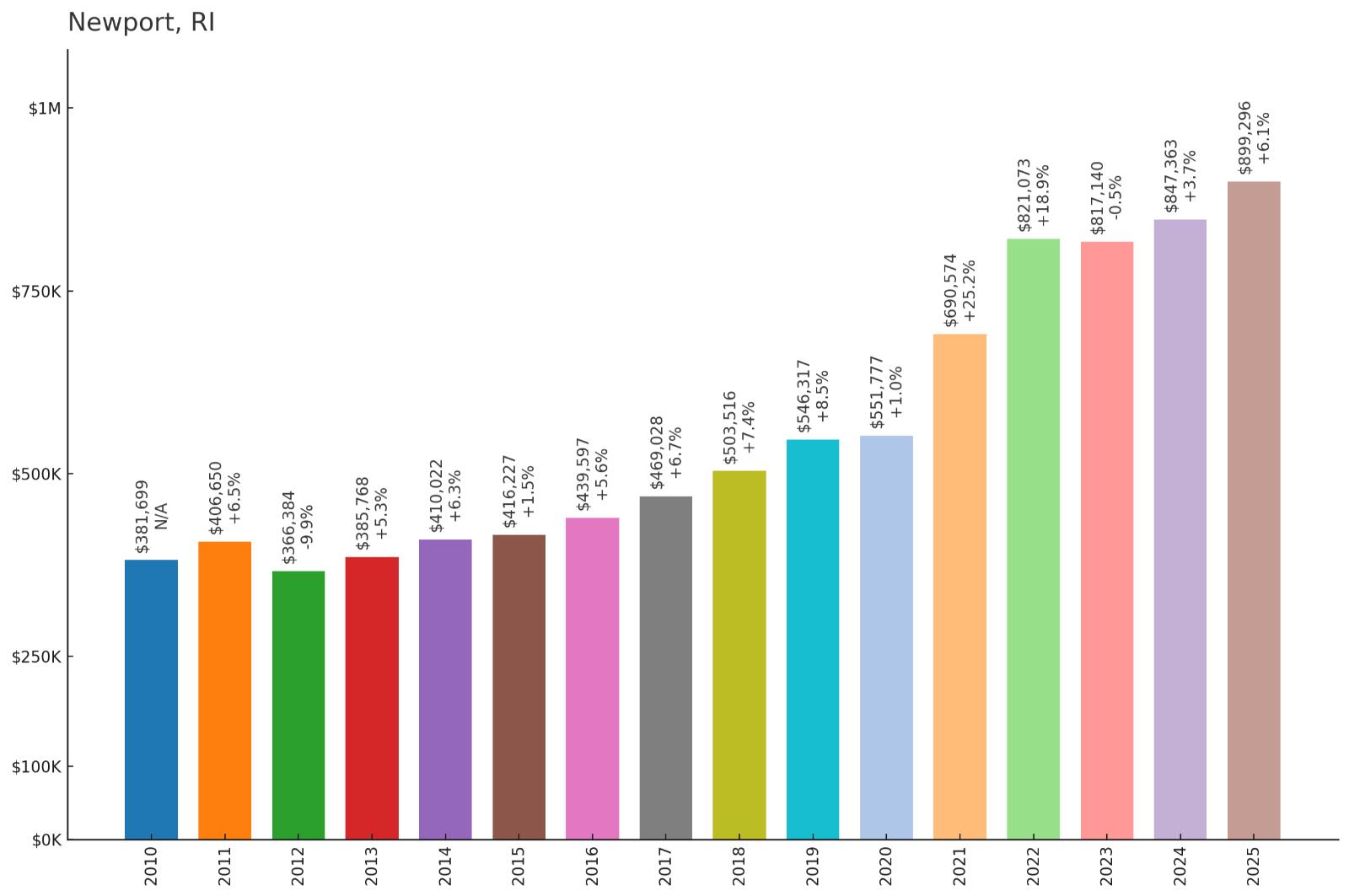
- 2010: $381,699
- 2011: $406,650
- 2012: $366,384
- 2013: $385,768
- 2014: $410,022
- 2015: $416,227
- 2016: $439,597
- 2017: $469,028
- 2018: $503,516
- 2019: $546,317
- 2020: $551,777
- 2021: $690,574
- 2022: $821,073
- 2023: $817,140
- 2024: $847,363
- 2025: $899,296
Newport demonstrated exceptional growth with values climbing 136% since 2010 to reach $899,296 by 2025. This world-renowned coastal destination showed consistent upward momentum with particularly strong gains during 2021-2022, reflecting intense buyer demand. The city’s combination of historic mansions, sailing heritage, and cultural attractions drives sustained premium pricing.
Why Newport?

Why are people willing to pay so much to live here? What’s special about it?
Newport attracts global buyers with its unmatched combination of Gilded Age mansions, sailing culture, and coastal beauty. The city offers grand mansions that once hosted presidents, diplomats, and industrial magnates, with panoramic views of Narragansett Bay and the Atlantic Ocean. Properties typically begin around $3 million, with high-profile estates surpassing $20 million depending on historical significance and waterfront access.
The community features world-class cultural attractions including the famous Cliff Walk, historic mansions, and prestigious sailing events that create international appeal. Newport’s vibrant downtown offers boutique shopping, fine dining, and cultural venues while maintaining authentic maritime character. This unique blend of history, luxury, and coastal living justifies premium pricing and sustained demand.
How Newport Rose to Prominence
Newport’s transformation into America’s premier summer destination began in the Gilded Age when industrial magnates built elaborate “cottages” along Bellevue Avenue and Ocean Drive. Landmark properties by Richard Morris Hunt, McKim, Mead & White, and other architectural giants created a legacy of fabulous estates that continue to define the city’s character.
The 20th century brought preservation efforts that protected these architectural treasures while developing Newport’s reputation as a sailing capital. The America’s Cup races, Jazz Festival, and other prestigious events established international recognition. Today, the city successfully balances historic preservation with modern luxury amenities, maintaining its position as one of New England’s most desirable destinations.
3 Interesting Tidbits
1. Mansion Legacy – Several Gilded Age mansions including Fairholme, Plaisance, and Wildacre remain in private hands, representing some of America’s most significant architectural treasures.
2. Sailing Capital – Newport’s harbor has hosted the America’s Cup and continues to attract world-class sailing events and prestigious yacht clubs.
3. Historic Preservation – Many properties fall under historic district guidelines that regulate changes, preserving the city’s authentic character while supporting property values.
3. Little Compton – 123% Home Price Increase Since 2010
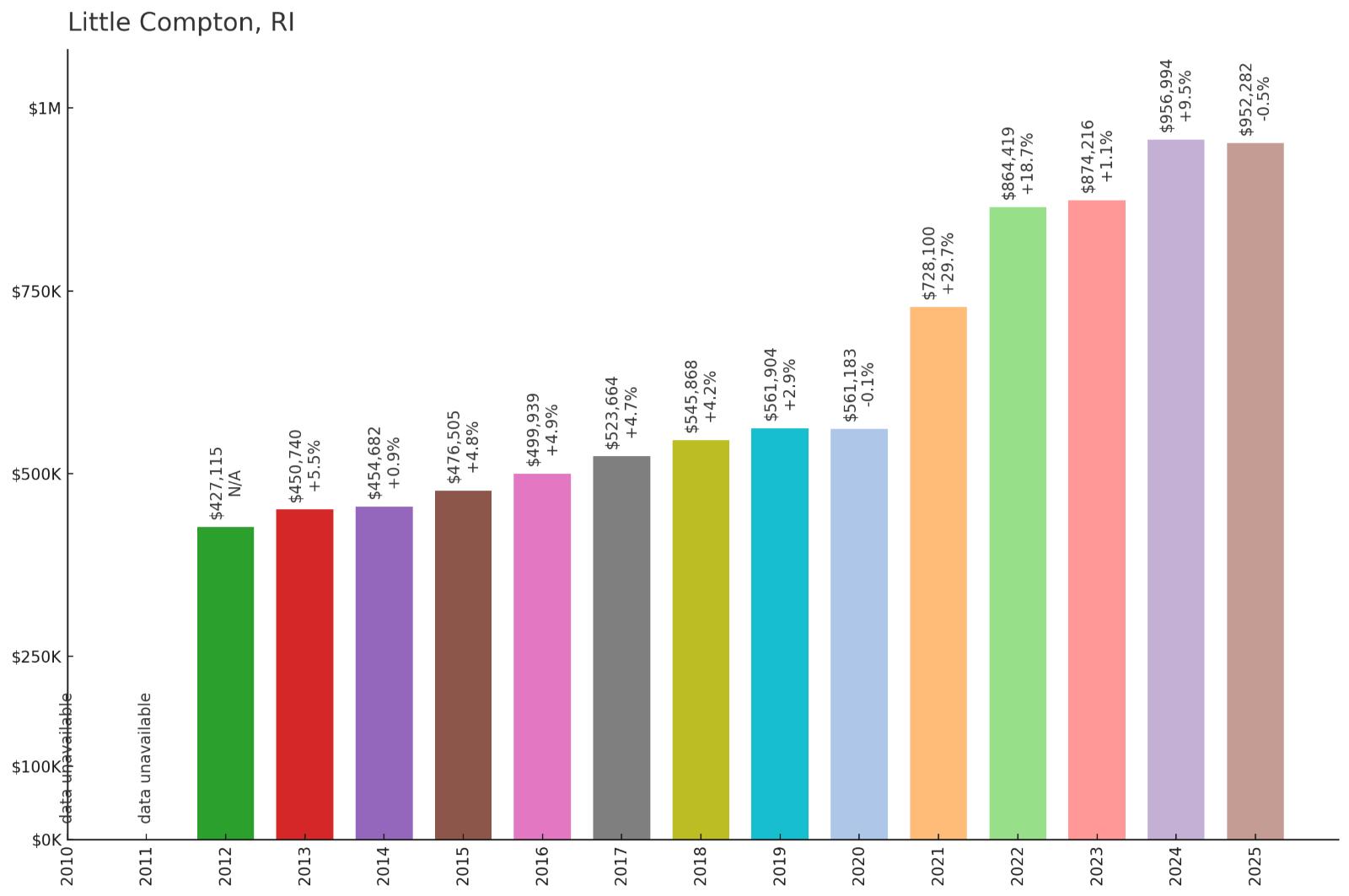
- 2010: N/A
- 2011: N/A
- 2012: $427,115
- 2013: $450,740
- 2014: $454,682
- 2015: $476,505
- 2016: $499,939
- 2017: $523,664
- 2018: $545,868
- 2019: $561,904
- 2020: $561,183
- 2021: $728,100
- 2022: $864,419
- 2023: $874,216
- 2024: $956,994
- 2025: $952,282
Little Compton showed remarkable growth with available data demonstrating a 123% increase from 2012 to reach $952,282 by 2025. This exclusive southeastern coastal community experienced dramatic acceleration after 2020, jumping from $561,183 to over $950,000 today. The exceptional performance reflects intense buyer demand for Little Compton’s pristine rural character, coastal access, and historic charm.
Why Little Compton?

Why are people willing to pay so much to live here? What’s special about it?
Little Compton attracts buyers seeking authentic New England coastal living with unspoiled rural character and dramatic ocean views. The town sits along the Sakonnet River and borders Massachusetts, offering pristine farms, historic sites like the Wilbor House Museum, and Sakonnet Point’s spectacular coastal scenery. Its agricultural heritage and coastal beauty create an unmatched combination of country and seaside living.
The community maintains working farms, preserved open spaces, and carefully controlled development that protects its essential character while supporting premium property values. Recent market analysis shows Little Compton had 32 home sales in 2023 with prices averaging over $1 million. The town’s commitment to preservation ensures that development remains compatible with its rural and coastal assets, appealing to buyers seeking exclusive, authentic New England living.
How Little Compton Rose to Prominence
Little Compton’s transformation into one of Rhode Island’s most exclusive communities began with recognition of its unique combination of coastal beauty, agricultural heritage, and rural tranquility. The town’s strategic location on the Sakonnet Peninsula provided coastal access while maintaining authentic farming character that became increasingly rare.
The 2000s brought increased attention to Little Compton’s lifestyle benefits, including working farms, coastal access, and preserved historic character. The town successfully resisted development pressures that transformed other coastal areas, maintaining the authentic rural and maritime character that drives premium pricing. This approach has created one of New England’s most exclusive residential markets.
3 Interesting Tidbits
1. Sakonnet Vineyards – The town features Rhode Island’s largest vineyard, producing award-winning wines while maintaining agricultural character.
2. Commons Heritage – Little Compton maintains one of New England’s most authentic colonial commons, complete with historic meetinghouse and cemetery.
3. Sakonnet Point – This dramatic coastal area offers spectacular ocean views and serves as a popular destination for visitors and residents alike.
2. Jamestown – 116% Home Price Increase Since 2010
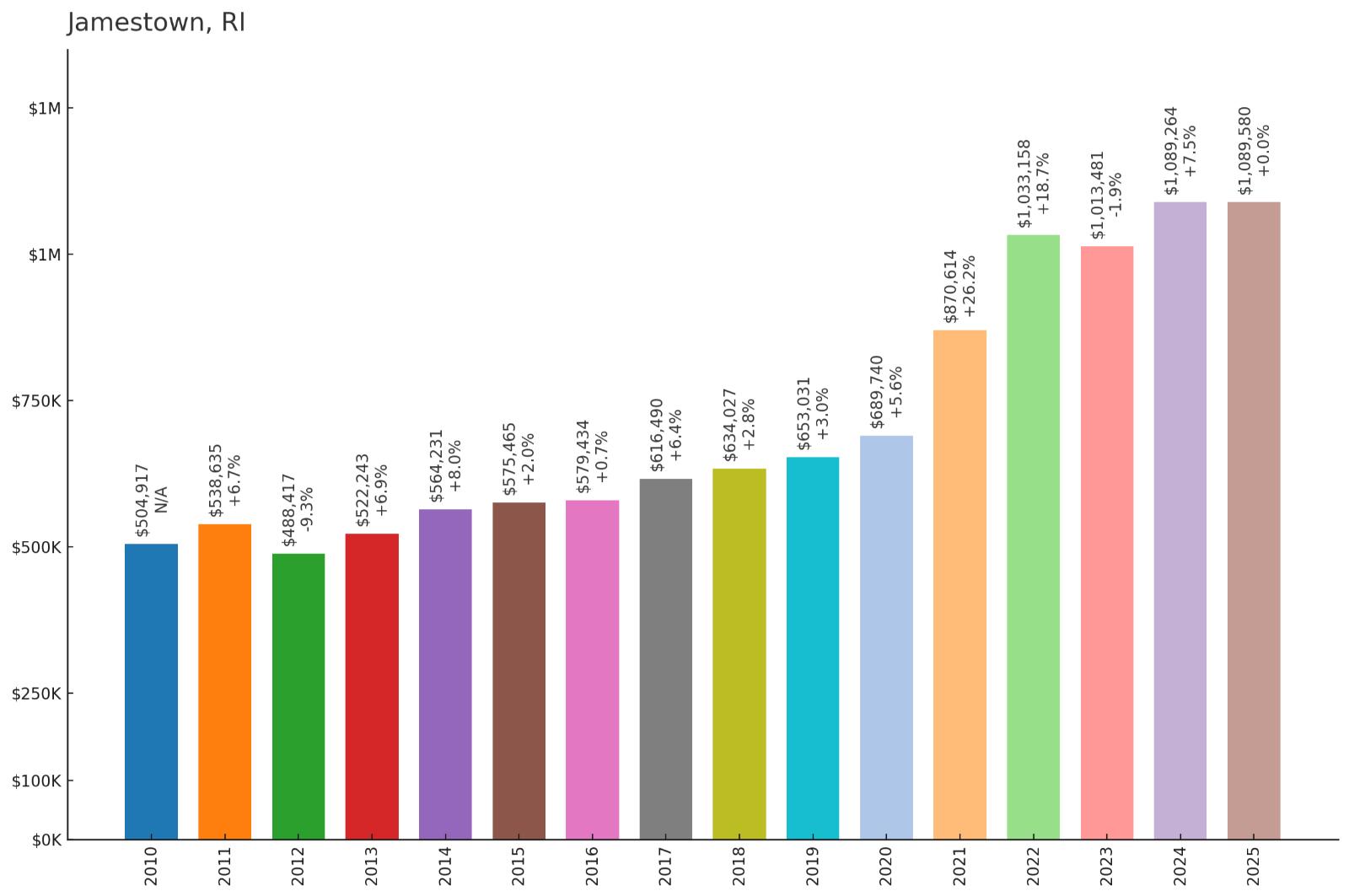
- 2010: $504,917
- 2011: $538,635
- 2012: $488,417
- 2013: $522,243
- 2014: $564,231
- 2015: $575,465
- 2016: $579,434
- 2017: $616,490
- 2018: $634,027
- 2019: $653,031
- 2020: $689,740
- 2021: $870,614
- 2022: $1,033,158
- 2023: $1,013,481
- 2024: $1,089,264
- 2025: $1,089,580
Jamestown achieved exceptional growth with values climbing 116% since 2010 to reach $1,089,580 by 2025, starting from an already premium baseline. This exclusive island community experienced dramatic acceleration after 2020, jumping from $689,740 to over $1 million today. The remarkable performance reflects intense buyer demand for Jamestown’s unique island location, stunning bay views, and exclusive character.
Why Jamestown?

Why are people willing to pay so much to live here? What’s special about it?
Jamestown’s exclusive island location and stunning Narragansett Bay views attract buyers seeking privacy and prestige with modern accessibility. Connected via bridges to Newport and mainland Rhode Island, the town balances convenience with secluded island charm that creates unique appeal. Prestigious neighborhoods like the Dumplings feature oceanfront estates while the historic village center maintains authentic small-town character.
The community offers natural beauty, strategic location, and carefully preserved character that attracts affluent professionals seeking both privacy and accessibility. Market analysis shows Jamestown had an average selling price of nearly $1.4 million in 2023, making it second among Rhode Island’s most expensive towns. Perhaps one of Jamestown’s most notable attractions is Beavertail State Park, featuring gorgeous coastal cliffs and the historical Beavertail Lighthouse that enhance the island’s appeal.
How Jamestown Rose to Prominence
Jamestown’s transformation into one of Rhode Island’s most exclusive communities began with recognition of its unique island character and strategic location between Newport and the mainland. The town’s natural beauty, preserved coastlines, and limited development created scarcity that drives premium pricing.
The late 20th century brought increased attention to Jamestown’s lifestyle benefits, including island living with urban accessibility, preserved natural areas, and exclusive residential neighborhoods. The community successfully maintained its character while attracting affluent residents who value privacy, natural beauty, and prestigious addresses. This approach has sustained demand and supported exceptional property value growth.
3 Interesting Tidbits
1. Beavertail Lighthouse – This historic lighthouse and state park provide spectacular coastal views and serve as iconic symbols of Jamestown’s maritime heritage.
2. The Dumplings – These exclusive waterfront neighborhoods feature some of Rhode Island’s most prestigious oceanfront estates with unmatched bay views.
3. Bridge Connections – Jamestown’s strategic location is enhanced by bridge connections to both Newport and the mainland, providing accessibility while maintaining island character.
1. New Shoreham – 129% Home Price Increase Since 2010
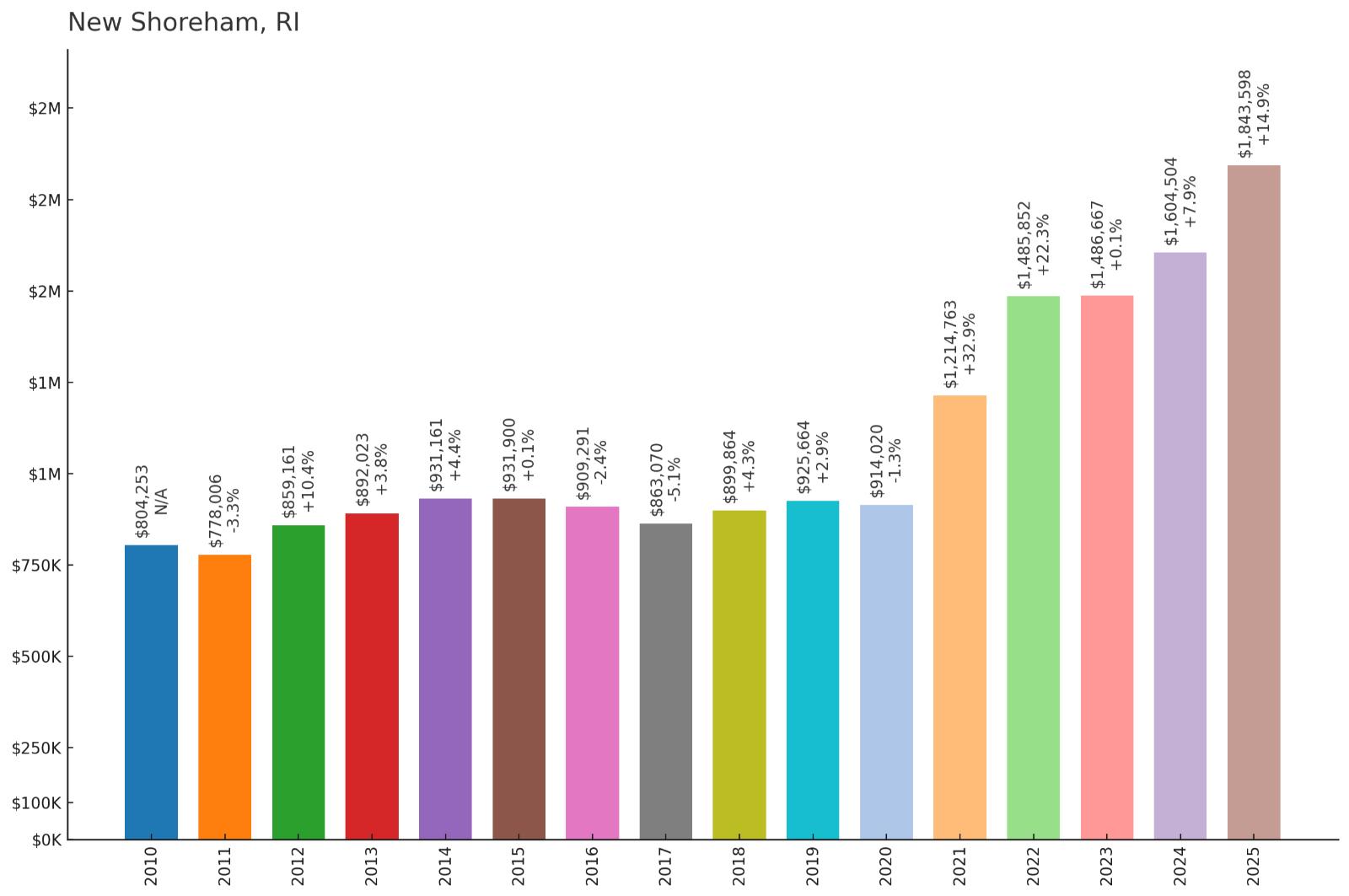
- 2010: $804,253
- 2011: $778,006
- 2012: $859,161
- 2013: $892,023
- 2014: $931,161
- 2015: $931,900
- 2016: $909,291
- 2017: $863,070
- 2018: $899,864
- 2019: $925,664
- 2020: $914,020
- 2021: $1,214,763
- 2022: $1,485,852
- 2023: $1,486,667
- 2024: $1,604,504
- 2025: $1,843,598
New Shoreham (Block Island) claims Rhode Island’s most expensive real estate, with values climbing 129% since 2010 to reach $1,843,598 by 2025. The island community experienced dramatic acceleration after 2020, jumping from $914,020 to nearly $1.85 million today. This exclusive destination combines limited inventory with unmatched natural beauty and seasonal appeal.
Why New Shoreham?

Why are people willing to pay so much to live here? What’s special about it?
New Shoreham on Block Island has been heralded as “One of the Last Twelve Great Places in the Western Hemisphere,” with rolling green hills and dramatic bluffs reminiscent of Ireland. The 11-square-mile island offers pristine beaches, 365 freshwater ponds, and carefully preserved natural landscapes that create an unparalleled living environment. Access by ferry or private plane adds exclusivity while maintaining the island’s peaceful character.
New Shoreham represents some of the most exclusive real estate in the state, with the island’s natural beauty, fiercely protected environment, and extremely limited housing stock making it one of the most coveted places to own a home in New England. The community’s strong conservation ethic ensures that development remains limited, protecting both the environment and property values for existing owners.
How New Shoreham Rose to Prominence
The first European settlers arrived in 1661, and in 1664, Block Island came under the jurisdiction of the Rhode Island colony, with the town of New Shoreham formally incorporated in 1672. The island’s isolation initially made it a fishing and farming community, but its natural harbors and strategic location gradually attracted seasonal visitors seeking pristine beaches and unspoiled landscapes.
The 20th century brought improved ferry service and recognition of Block Island’s unique character, leading to conservation efforts that now protect nearly half the island. The real estate market tends to be high because there are limited options, with people hanging on to their houses for generations, though the tax rate is very low. This scarcity, combined with the island’s designation as a premier natural area, creates intense competition for available properties.
3 Interesting Tidbits
1. Nature Conservancy Paradise – Nearly half the island remains undeveloped through the Block Island Nature Conservancy, which operates a large trail system offering walking and hiking paths through grassy meadows, quiet woods, and along sandy shores.
2. Lighthouse Legacy – The island features two historic lighthouses, including the famous Southeast Lighthouse, which was moved back from eroding bluffs in a dramatic 1993 engineering feat.
3. Seasonal Population Boom – During summer months, the island’s population swells with visitors from around the world, though year-round residents number fewer than 1,000 people.


